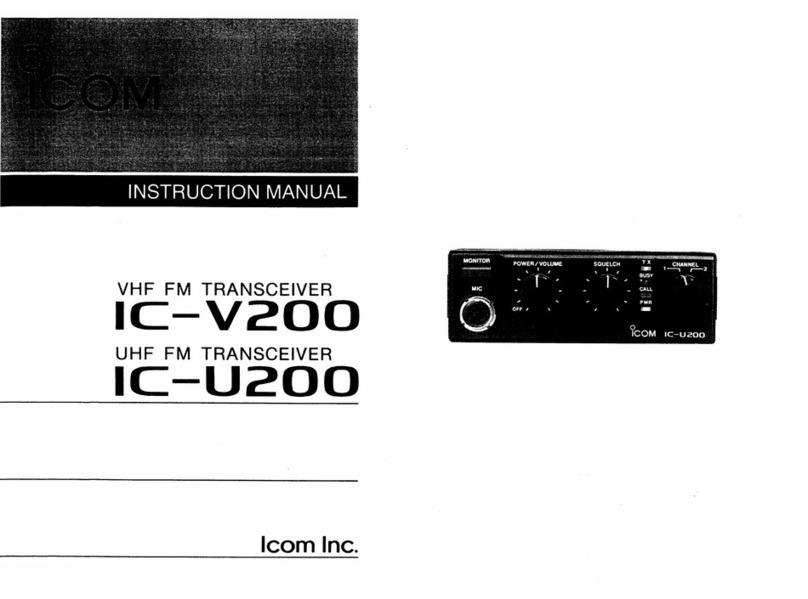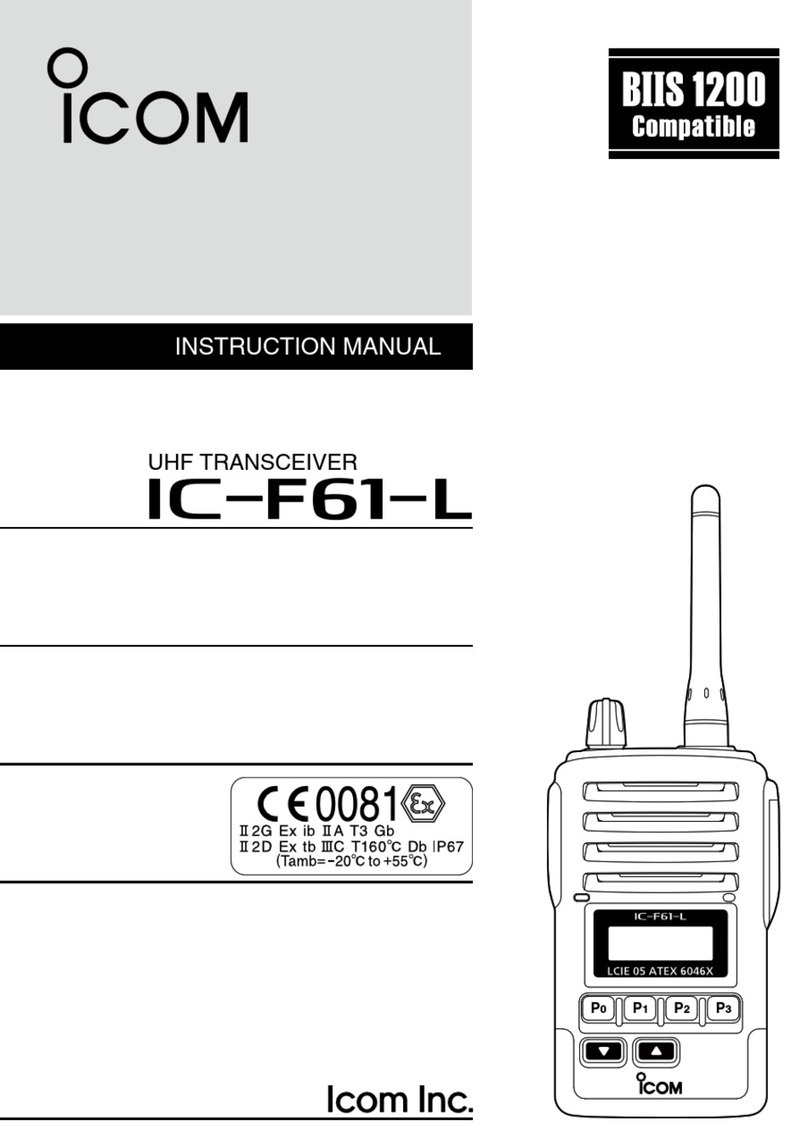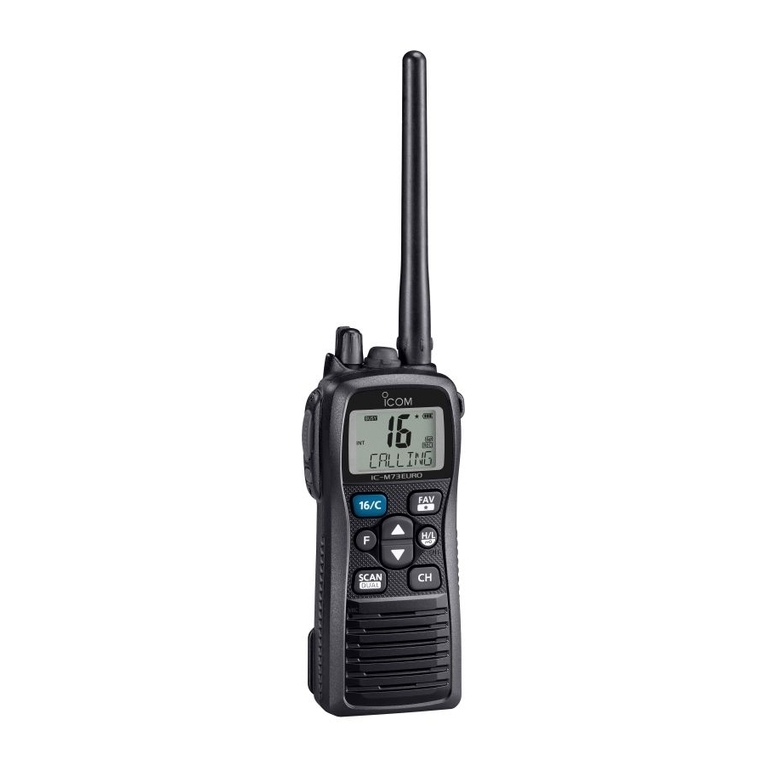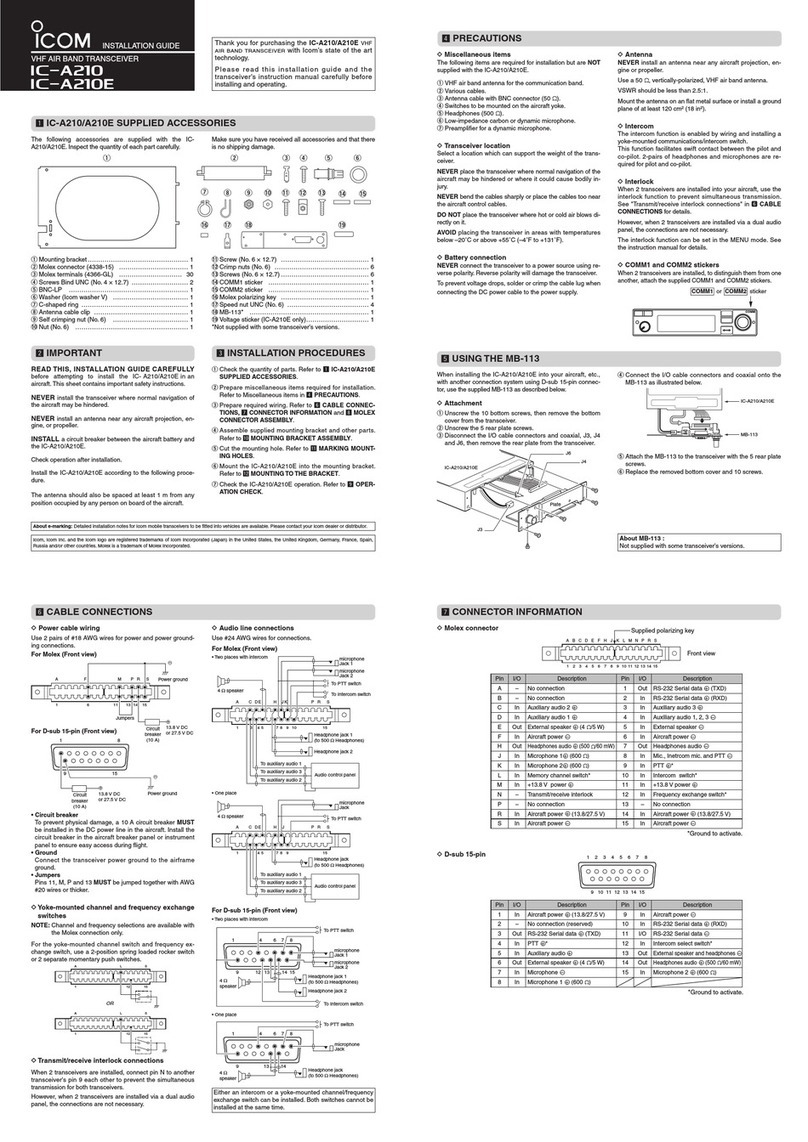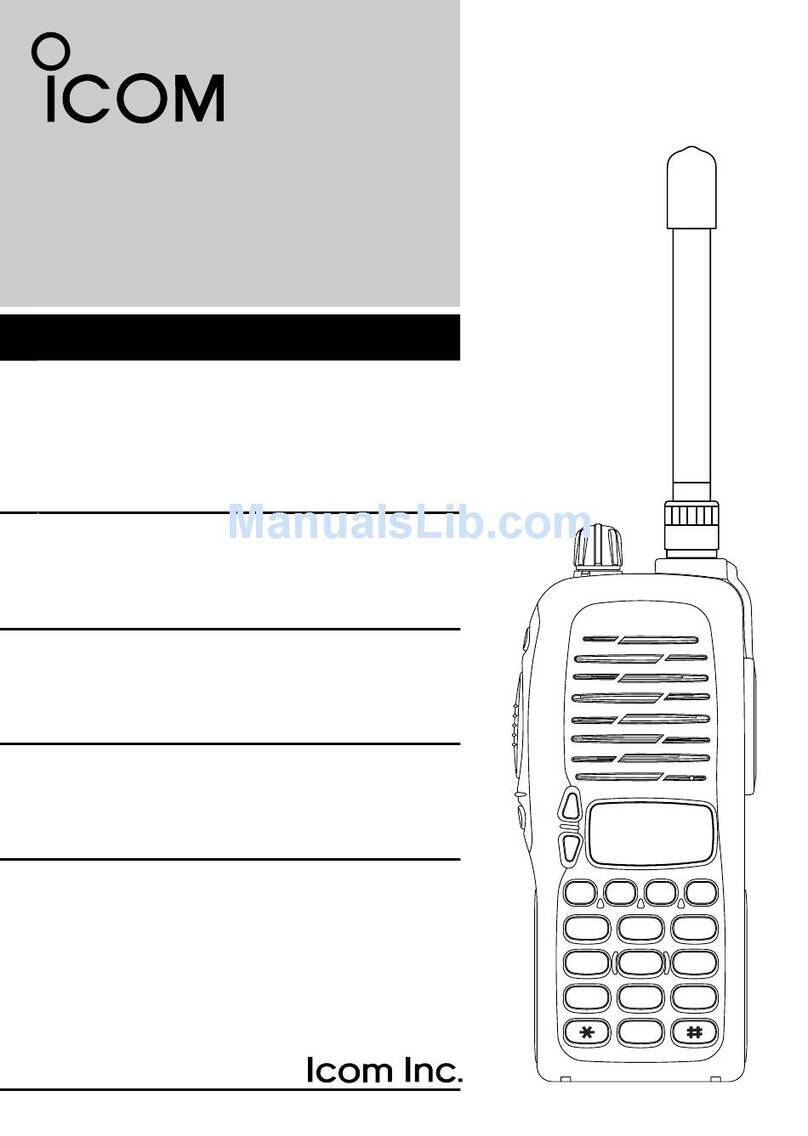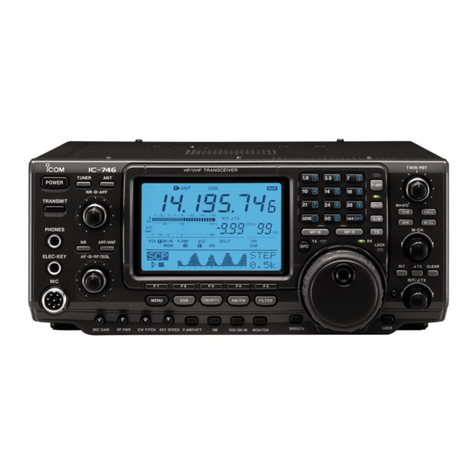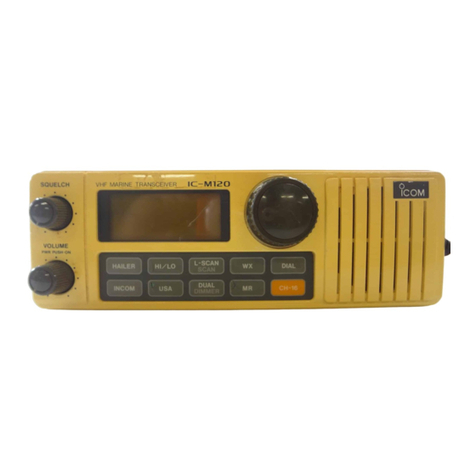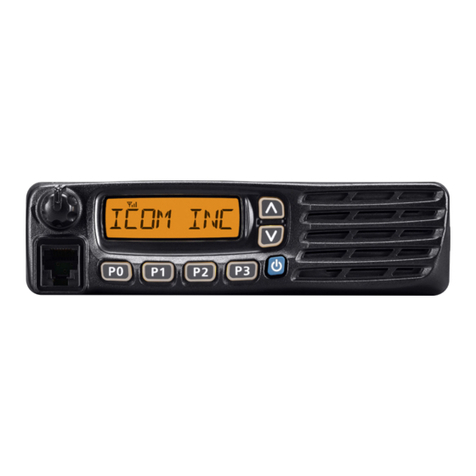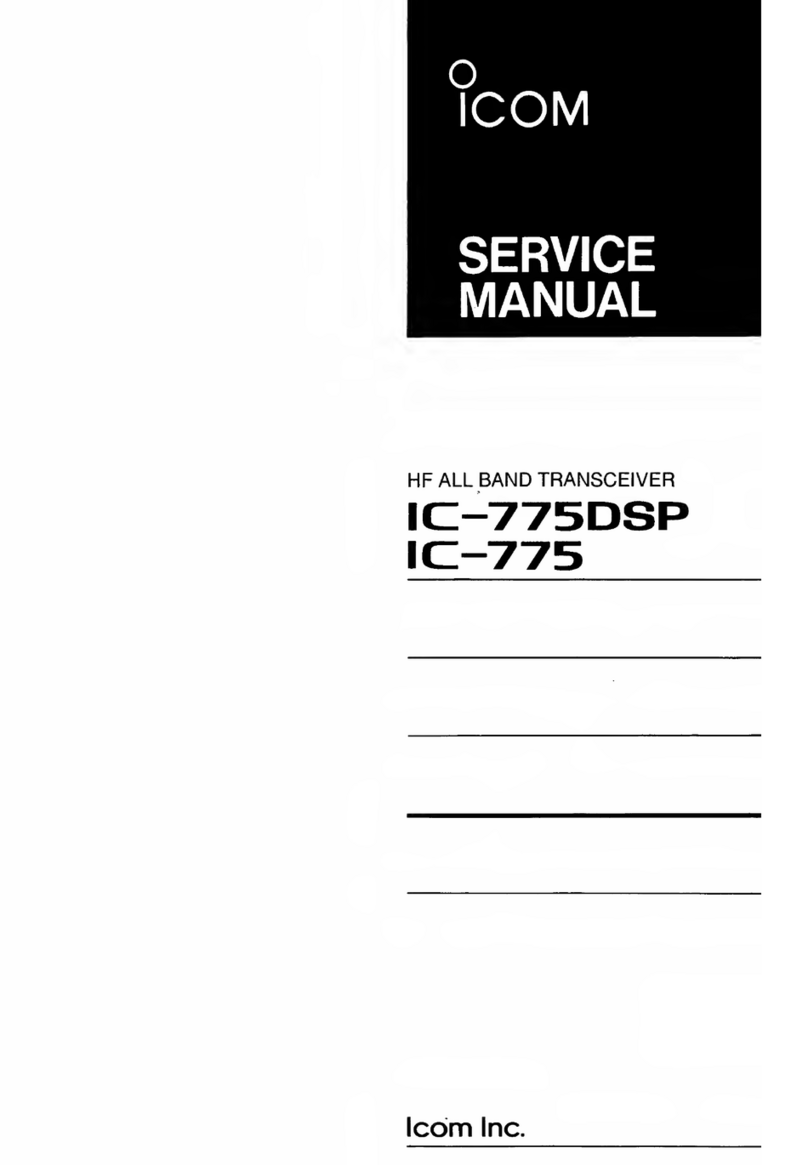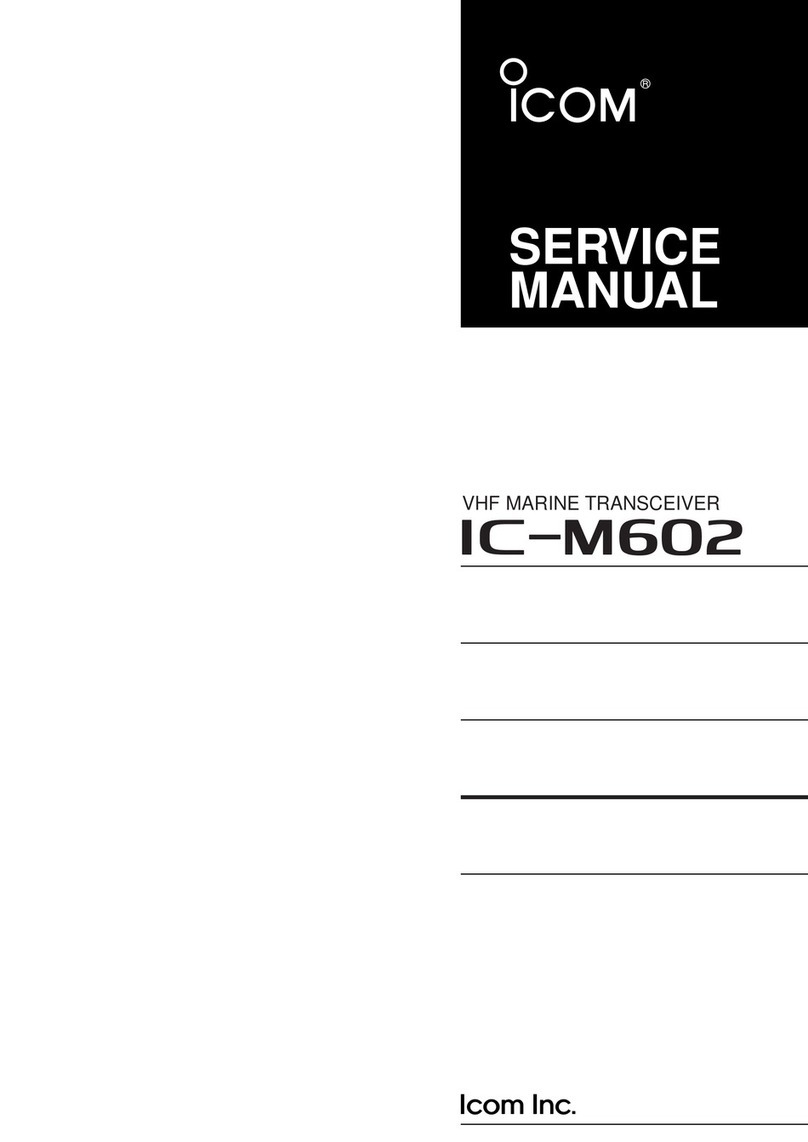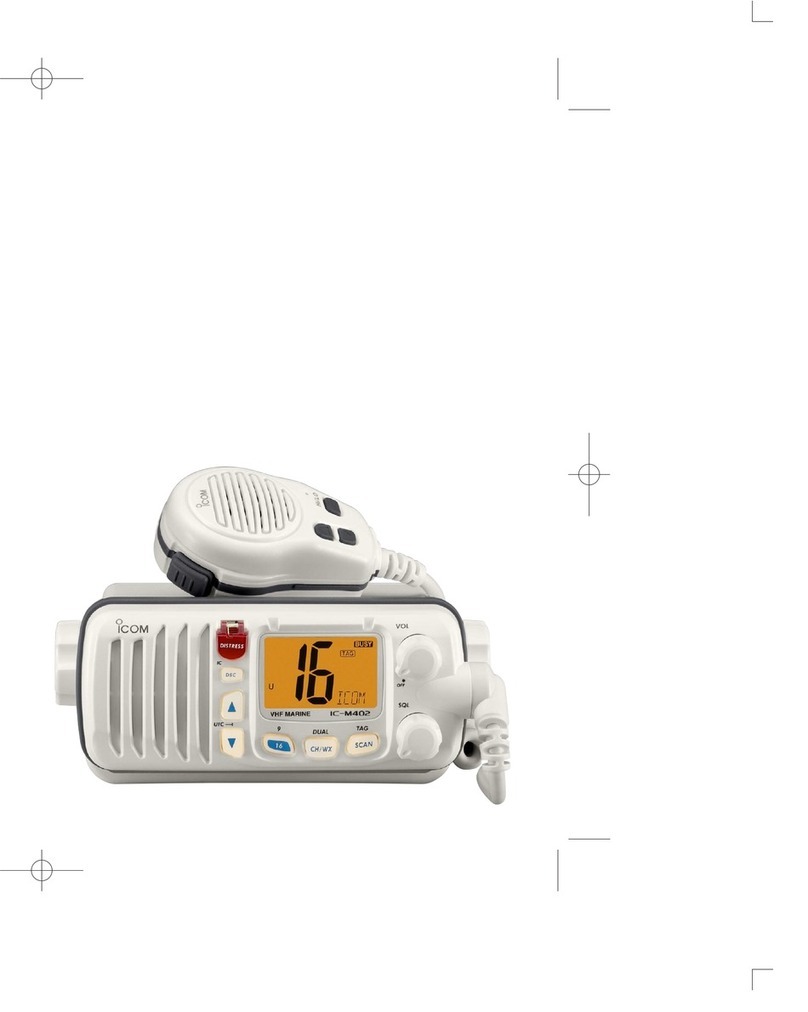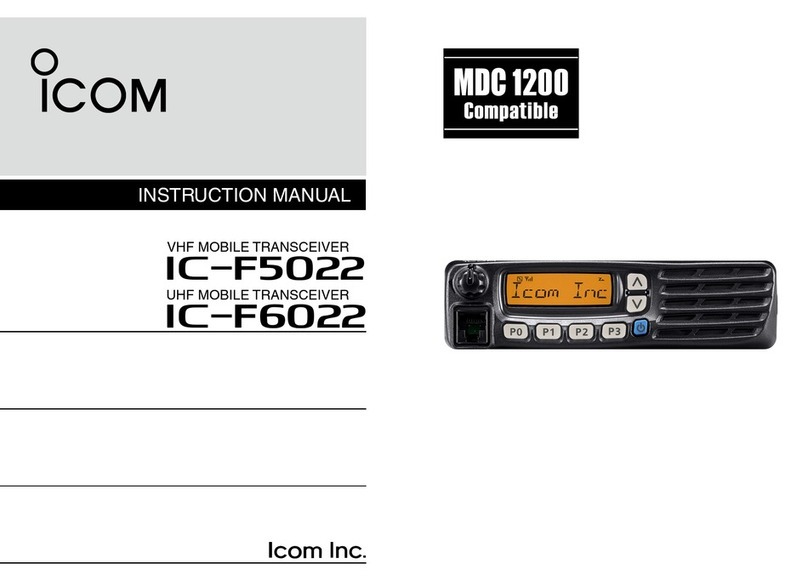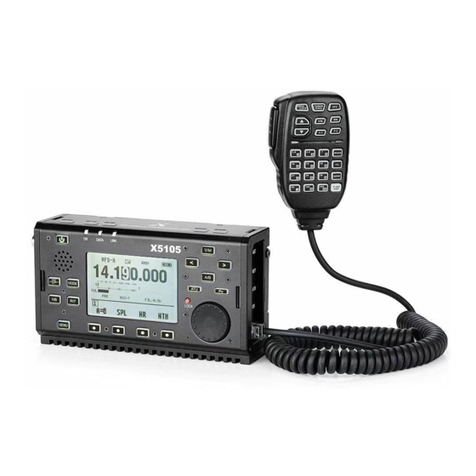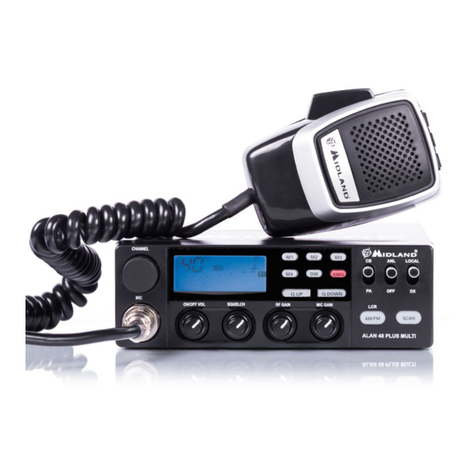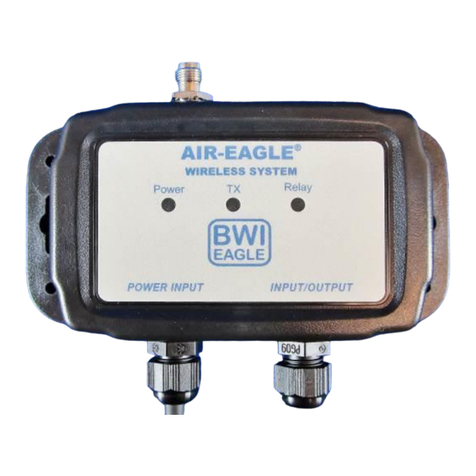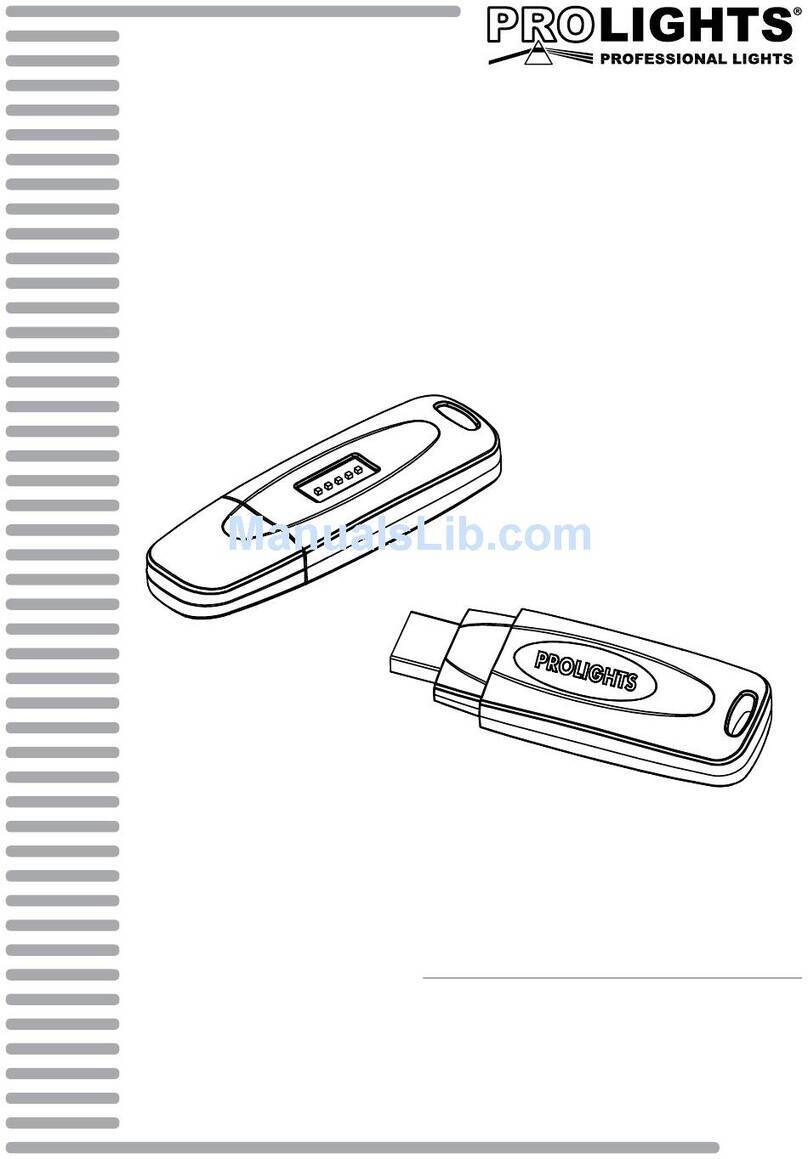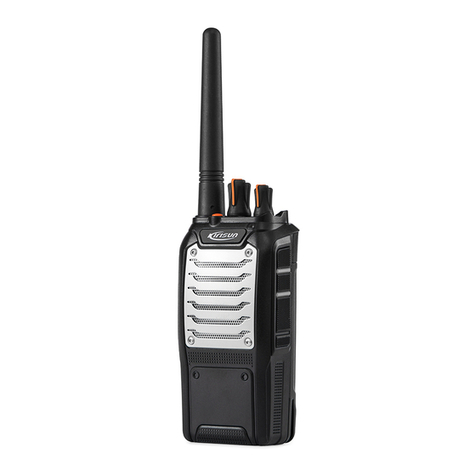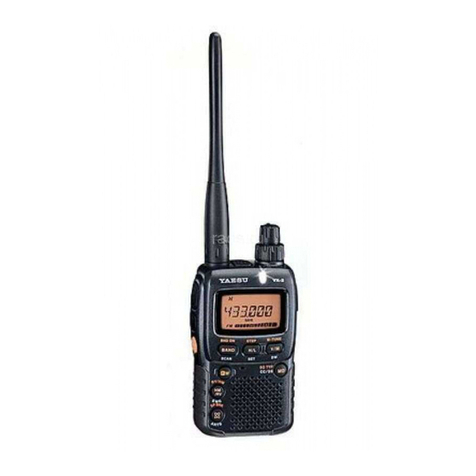Icom IC-7000 User manual

2001 NEW
HF/VHF/UHF
ALL MODE TRANSCEIVER
i7000
INSTRUCTION MANUAL

i-1
THIS PAGE
OPEN
IMPORTANT
READ THIS INSTRUCTION MANUAL
CAREFULLY before attempting to operate the
transceiver.
SAVE THIS INSTRUCTION MANUAL. This
manual contains important safety and operating
instructions for the IC-7000.
EXPLICITDEFINITIONS
WORD DEFINITION
RDANGER! Personal death, serious injury or an
explosion may occur.
RWARNING! Personal injury, fire hazard or
electric shock may occur.
CAUTION Equipment damage may occur.
NOTE
Recommended for optimum use. No
risk of personal injury, fire or electric
shock.
We understand that you have a choice of many
different radios in the market place. We want to take
a couple of moments of your time to thank you for
making the IC-7000 your radio of choice, and hope
you agree with Icom’s philosophy of “technology first.”
Many hours of research and development went into
the design of your IC-7000.
DFEATURES
❍IF DSP features
❍All mode capability covering 160–2 m and
70 cm (depending on version)
❍Compact with detachable front panel
❍±0.5 ppm of high frequency stability
❍Baudot RTTY demodulator
❍Simple band scope function
❍Selectable SSB transmission passband
width (For both higher and lower pass
frequency)
❍Standard voice synthesizer/voice recorder
The transceiver comes with the following accesso-
ries. Qty.
q Hand microphone (HM-151) ....................... 1
w DC power cable* (OPC-1457) ..................... 1
or (OPC-1457R) .................. 1
e Spare fuse (ATC 5 A) .................................. 1
r Spare fuse (ATC 30 A) ................................ 2
tACC cable..................................................... 1
y3.5 (d) mm plug............................................. 1
u6.5 (d) mm Electronic keyer plug .................. 1
iMicrophone hanger ....................................... 1
oFerrite bead**................................................ 1
* Depending on the version.
**Not supplied with the non-European versions.
q
e
t
w
w
yu
r
i
o
For European versions
(see page 19 for installation details)
FOREWORD SUPPLIED ACCESSORIES
Icom, Icom Inc. and the Icom logo are registered
trademarks of Icom Incorporated (Japan) in Japan, the
United States, the United Kingdom, Germany, France,
Spain, Russia and/or other countries.
Spurious signals may be received near the following
frequencies. These are created in the internal circuit and
does not indicate a transceiver malfunction:
52.76497 MHz,
443.03535 MHz

i-2
2001 NEW
SPCH
/LOCK
TUNER
/CALL XFC
V/M
F-1 F-2
FIL
MODE
GENE
MW
123
456
789
.
0
CE
F-INP
ENT
1.8 3.5 7
10 14 18
21 24 28
50 144 430
Mic element
q
e
w
o
!7!8!9@0@2@3@4 @1
t
r
yu !2
!5
!6
!1!0i
!3
!4
z
c
v
bn
m
,
.⁄0
⁄2
⁄3
⁄1
x
Front panel
HM-151
ILLUSTRATIONS
The front panel and HM-151’s panel
descriptions are described on pages 1
to 4, and on page 9, respectively (see
the Chapter 1 ‘PANEL DESCRIPTION’
for more details).

2001 NEW
i-3
■Front panel
q AF GAIN CONTROL [AF] (inner control; p. 33)
wRF GAIN CONTROL/SQUELCH CONTROL [RF/
SQL] (outer control; p. 35)
ePOWER KEY [PWR] (p. 25)
r FRONT PANEL LATCH (p. 16)
tPASSBAND TUNING/M-ch/RIT CONTROLS
[PBT/M-ch/RIT] (pp. 73, 77, 86, 100, 104)
yTWIN PBT (M-ch/RIT) INDICATOR
(pp. 73, 77, 86, 100)
uMENU/GROUP KEYS [MENU/GRP] (p. 151)
iTUNER/CALL KEY [TUNER/CALL]
(pp. 100, 114)
oMULTI-FUNCTION KEYS [F1]/[F2]/[F3]/[F4]
(pp. 5–8, 151)
!0 MANUAL NOTCH KEY [MNF/ADJ] (p. 81)
!1 AUTO NOTCH/VOICE RECORDER KEY
[ANF/•REC] (pp. 80, 93)
!2 SPCH/LOCK KEY [SPCH/LOCK] (pp. 34, 37)
!3 MICROPHONE CONNECTOR (p. 10)
!4
UP/DOWN (BAND) KEYS
[p(b a n d )]/[q(b a n d )]
!5 MAIN DIAL TENSION LATCH
!6 HEADPHONE JACK [PHONES] (p. 18)
!7 MAIN DIAL [DIAL]
!8 RECEIVE/TRANSMIT INDICATORS [RX]/[TX]
!9 TUNING STEP KEY [TS] (pp. 30–32)
@0 NOISE BLANKER KEY [NB/ADJ] (p. 78)
@1 NOISE REDUCTION KEY [NR/LEV] (p. 79)
@2 FUNCTION DISPLAY (p. 13)
@3 PRE AMP/ATTENUATOR KEY [P.AMP/ATT]
(p. 72)
@4 MODE KEY [MODE] (p. 34)
■Microphone (HM-151)
zSPCH/LOCK KEY [SPCH/LOCK] (p. 34, 37)
xPTT SWITCH [PTT] (p. 37)
cUP/DOWN SWITCHES [Y]/[Z]
vTRANSMIT INDICATOR (p. 37)
bKEYPAD (pp. 28, 29)
nFILTER SELECTION [FIL] (p. 75)
mMODE KEY [MODE] (p. 34)
,POWER INDICATOR
.PROGRAMMABLE FUNCTION KEYS [F-1]/[F-2]
⁄0 MEMORY WRITE [MW] (pp. 101, 102)
⁄1 VFO/MEMORY SELECTION [V/M]
(pp. 27, 100, 107)
⁄2 TRANSMIT FREQUENCY CHECK [XFC]
(pp. 65, 89)
⁄3 TUNER/CALL KEY [TUNER/CALL]
(pp. 100, 114)

ii
RDANGER HIGH VOLTAGE! NEVER touch an an-
tenna or internal antenna connector during transmission.
This may result in an electrical shock or burn.
RWARNING RF EXPOSURE! This device emits Radio
Frequency (RF) energy. Extreme caution should be ob-
served when operating this device. If you have any questions
regarding RF exposure and safety standards please refer
to the Federal Communications Commission Office of Engi-
neering and Technology’s report on Evaluating Compliance
with FCC Guidelines for Human Radio Frequency Electro-
magnetic Fields (OET Bulletin 65).
RWARNING! NEVER operate the transceiver while driv-
ing a vehicle. Safe driving requires your full attention—any-
thing less may result in an accident.
RWARNING! NEVER operate the transceiver with an
earphone, headphones or other audio accessories at high
volume levels. Hearing experts advise against continuous
high volume operation. If you experience a ringing in your
ears, reduce the volume level or discontinue use.
RWARNING! NEVER apply AC power to the [DC13.8V]
socket on the transceiver rear panel. This could cause a fire
or damage the transceiver.
RWARNING! NEVER apply more than 16 V DC to the
[DC13.8V] socket on the transceiver rear panel or use reverse
polarity. This could cause a fire or damage the transceiver.
RWARNING! NEVER let metal, wire or other objects
touch any internal part or connectors on the rear panel of the
transceiver. This may result in an electric shock or this could
cause a fire or damage the transceiver.
RWARNING! NEVER operate or touch the transceiver
with wet hands. This may result in an electric shock or may
damage the transceiver.
RWARNING! Immediately turn the transceiver power OFF
and remove the power cable if it emits an abnormal odor, sound
or smoke. Contact your Icom dealer or distributor for advice.
CAUTION: NEVER connect or use the supplied HM-151
(microphone) with other transceiver. This could cause dam-
age to the transceiver. The HM-151 is designed for use with
the IC-7000 ONLY.
CAUTION: NEVER expose the transceiver to rain, snow
or any liquids.
CAUTION: NEVER change the internal settings of the
transceiver. This may reduce transceiver performance and/
or damage to the transceiver.
DO NOT use harsh solvents such as benzine or alcohol to
clean the transceiver, as they will damage the transceiver’s
surfaces. If the transceiver becomes dusty or dirty, wipe it
clean with a soft, dry cloth.
DO NOT use or place the transceiver in areas with temper-
atures below –10°C (+14°F) or above +60°C (+140°F). Be
aware that temperatures on a vehicle’s dashboard can ex-
ceed +80°C (+176°F), resulting in permanent damage to the
transceiver if left there for extended periods.
DO NOT place the transceiver in excessively dusty environ-
ments or in direct sunlight.
DO NOT place the transceiver against walls or putting anything
on top of the transceiver. This will obstruct heat dissipation.
Place the transceiver in a secure place to avoid inadvertent use
by children.
During mobile operation, NEVER place the transceiver
where air bag deployment may be obstructed.
During mobile operation, DO NOT place the transceiver
where hot or cold air blows directly onto it.
During mobile operation, DO NOT operate the transceiver
without running the vehicle’s engine. When the transceiver’s
power is ON and your vehicle’s engine is OFF, the vehicle’s
battery will soon become exhausted.
Make sure the transceiver power is OFF before starting the
vehicle engine. This will avoid possible damage to the trans-
ceiver by ignition voltage spikes.
During maritime mobile operation, keep the transceiver and
microphone as far away as possible from the magnetic navi-
gation compass to prevent erroneous indications.
BE CAREFUL! The rear panel will become hot when operat-
ing the transceiver continuously for long periods of time.
BE CAREFUL! If a linear amplifier is connected, set the
transceiver’s RF output power to less than the linear ampli-
fier’s maximum input level, otherwise, the linear amplifier will
be damaged.
Use Icom microphones only (supplied or optional). Other
manufacturer’s microphones have different pin assignments,
and connection to the IC-7000 may damage the transceiver.
PRECAUTIONS
FCC INFORMATION
• FOR CLASS B UNINTENTIONAL RADIATORS:
This equipment has been tested and found to comply with the
limits for a Class B digital device, pursuant to part 15 of the
FCC Rules. These limits are designed to provide reasonable
protection against harmful interference in a residential instal-
lation. This equipment generates, uses and can radiate radio
frequency energy and, if not installed and used in accordance
with the instructions, may cause harmful interference to radio
communications. However, there is no guarantee that interfer-
ence will not occur in a particular installation. If this equip-
ment does cause harmful interference to radio or television
reception, which can be determined by turning the equipment
off and on, the user is encouraged to try to correct the inter-
ference by one or more of the following measures:
• Reorient or relocate the receiving antenna.
• Increase the separation between the equipment and re-
ceiver.
• Connect the equipment into an outlet on a circuit differ-
ent from that to which the receiver is connected.
• Consult the dealer or an experienced radio/TV techni-
cian for help.
CAUTION: Changes or modifications to this transceiver,
not expressly approved by Icom Inc., could void your
authority to operate this transceiver under FCC
regulations.

iii
2001 NEW 2001 NEW
IMPORTANT������������������������������������������������������������ i-1
FOREWORD ���������������������������������������������������������� i-1
EXPLICIT DEFINITIONS���������������������������������������� i-1
SUPPLIED ACCESSORIES������������������������������������ i-1
ILLUSTRATIONS ���������������������������������������������������� i-2
■Front panel....................................................... i-3
■Microphone (HM-151)...................................... i-3
PRECAUTIONS��������������������������������������������������������� ii
FCC INFORMATION ������������������������������������������������� ii
TABLE OF CONTENTS ������������������������������������������ iii
1 PANEL DESCRIPTION �������������������������� 1–14
■Front panel......................................................... 1
■Multi-function keys ............................................. 5
DMenu M-1 functions ....................................... 5
DMenu M-2 functions ....................................... 5
DMenu M-3 functions ....................................... 5
DMenu S-1 functions......................................... 7
DMenu S-2 functions ........................................ 7
DMenu S-3 functions......................................... 8
DMenu G-1 (Scope) functions........................... 8
■Microphone (HM-151)........................................ 9
DMicrophone connector.................................. 10
■Rear panel ....................................................... 11
DDATA socket.................................................. 12
DACC socket................................................... 12
■Function display............................................... 13
2 INSTALLATION AND CONNECTIONS 15–24
■Unpacking........................................................ 15
■Selecting a location.......................................... 15
■Grounding........................................................ 15
■Antenna connection......................................... 15
■Installation........................................................ 16
DSingle body mounting................................... 16
DStand ............................................................ 16
DFront panel separation.................................. 16
DFront panel mounting.................................... 16
■Required connections...................................... 17
■Advanced connections..................................... 18
■Power supply connections ............................... 19
■Connecting a DC power supply ....................... 19
■Battery connections ........................................ 20
■External antenna tuners .................................. 20
■Linear amplifier connections............................ 21
■Connections for CW......................................... 22
■Connections for RTTY ..................................... 23
DConnections for RTTY (FSK)........................ 23
DConnections for RTTY (AFSK) ..................... 23
■Connections for packet, SSTV or PSK31 ........ 24
DWhen connecting to [DATA] socket............... 24
DWhen connecting to [ACC] socket ................ 24
DWhen connecting to [MIC] connector ........... 24
3 BASIC OPERATION ����������������������������� 25–38
■When first applying power (CPU resetting)...... 25
DMenu resetting (M-1)................................... 25
■Initial settings................................................... 25
■VFO description ............................................... 26
DDifferences between VFO and
memory mode .............................................. 26
■VFO operation.................................................. 27
DSelecting VFO A/VFO B ............................... 27
DVFO equalization .......................................... 27
■Selecting VFO/memory mode.......................... 27
■Selecting an operating band............................ 28
DUsing the band stacking registers ................ 28
■Frequency setting ............................................ 29
DTuning with the main dial .............................. 29
DDirect frequency entry
with the microphone’s keypad ...................... 29
DProgrammable tuning step ........................... 30
DSelecting “kHz” step...................................... 30
DSelecting 1 Hz or 10 Hz step
(SSB/CW/RTTY only) ................................... 31
D1 MHz quick tuning step
(FM/WFM/AM only) ...................................... 31
D
1⁄4tuning function (CW/RTTY only)............... 32
DAuto tuning step function .............................. 33
DBand edge warning beep ............................. 33
■Volume setting ................................................. 33
■Operating mode selection................................ 34
■Voice synthesizer function ............................... 34
■Squelch and receive (RF) sensitivity ............... 35
■Meter function.................................................. 36
DMulti-function meter...................................... 36
■Lock functions.................................................. 37
DDial lock function .......................................... 37
DMicrophone lock function.............................. 37
■Basic transmit operation .................................. 37
DTransmitting .................................................. 37
DSetting output power..................................... 38
DSetting microphone gain............................... 38
4 RECEIVE AND TRANSMIT ������������������ 39–69
■Operating SSB................................................. 39
DConvenient functions for receive .................. 39
DConvenient functions for transmit ................. 40
DAbout 5 MHz band operation
(USA version only)........................................ 40
■Operating CW .................................................. 41
DConvenient functions for receive .................. 42
DConvenient functions for transmit ................. 42
DCW reverse mode......................................... 43
DCW side tone function .................................. 43
DCW pitch control ........................................... 44
■Electronic CW keyer ........................................ 45
DMemory keyer send menu ............................ 46
DEditing a keyer memory................................ 47
DContest number Set mode............................ 48
1 Number Style ............................................. 48
2 Count UP Trigger ....................................... 48
3 Present Number......................................... 48
DKeyer Set mode ............................................ 49
1 Keyer Repeat Time .................................... 49
2 Dot/Dash Ratio .......................................... 49
3 Rise Time................................................... 50
TABLE OF CONTENTS

iv
2001 NEW
4 Paddle Polarity ........................................... 50
5 Keyer Type ................................................. 50
6 MIC U/D Keyer (HM-103)........................... 50
DPaddle operation from [MIC] connector........ 50
■Operating RTTY (FSK) .................................... 51
DConvenient functions for receive .................. 52
DRTTY reverse mode ..................................... 53
DTwin peak filter.............................................. 53
DFunctions for the RTTY decoder indication .. 54
DSetting the decoder threshold level .............. 54
DRTTY decode Set mode ............................... 55
1 RTTY Decode USOS................................. 55
2 RTTY Decode New Line Code................... 55
D
Pre-setting for using RTTY terminal or TNC
.... 56
■Operating AM................................................... 57
DConvenient functions for receive .................. 57
DConvenient functions for transmit ................. 58
■Operating FM................................................... 59
DConvenient functions for receive .................. 59
DConvenient functions for transmit ................. 59
DTone squelch operation................................. 60
DDTCS operation............................................ 61
DTone scan operation ..................................... 62
■Repeater operation.......................................... 63
DOne-touch repeater function......................... 63
DRepeater tone frequency.............................. 64
DTransmit frequency monitor check................ 65
DAuto repeater function (USA version only) ... 65
DStoring a non standard repeater................... 66
■1750 Hz tone burst .......................................... 67
■DTMF memory encoder................................... 67
DDTMF send menu......................................... 67
DProgramming a DTMF code ......................... 68
DDTMF speed................................................. 68
5 FUNCTIONS FOR RECEIVE ���������������� 69–82
■Simple band scope .......................................... 69
DFix mode....................................................... 70
DCenter mode................................................. 71
DScope Set mode........................................... 71
1 Max Hold.................................................... 72
2 Scope Size................................................. 72
3 FAST Sweep .............................................. 72
4 FAST Sweep Sound................................... 72
■Preamp and attenuator.................................... 72
■RIT function ..................................................... 73
■AGC function ................................................... 74
DAGC time constant selection ........................ 74
DSetting the AGC time constant ..................... 74
■IF filter selection............................................... 75
DIF filter selection ........................................... 75
DFilter passband width setting
(SSB/CW/RTTY/AM only)............................. 76
DIF filter shape (SSB/CW only)....................... 76
■Twin PBT operation.......................................... 77
■Noise blanker................................................... 78
DNoise blanker Set mode ............................... 78
1 NB Level .................................................... 78
2 NB Width.................................................... 78
■Noise reduction................................................ 79
DNoise reduction Set mode ............................ 79
➥NR Level................................................... 79
■Notch function.................................................. 80
DAuto notch function....................................... 80
DManual notch function .................................. 81
DManual notch filter Set mode........................ 81
■Voice squelch control function ......................... 82
■Meter peak hold function ................................. 82
6 FUNCTIONS FOR TRANSMIT�������������� 83–92
■VOX function .................................................... 83
DAdjusting the VOX function ........................... 83
DVOX Set mode .............................................. 84
1 VOX Gain ................................................... 84
2 Anti-VOX .................................................... 84
3 VOX Delay.................................................. 84
■Transmit filter width setting (SSB only) ............ 84
■Break-in function.............................................. 85
DSemi break-in operation ............................... 85
DFull break-in operation.................................. 85
■∂TX function.................................................... 86
■Monitor function ............................................... 87
■Speech compressor......................................... 87
DCompression level setting............................. 88
➥COMP Level ............................................. 88
■Split frequency operation................................. 89
■Quick split function........................................... 90
DSplit offset frequency setting ........................ 91
DQuick split setting ......................................... 91
■ Measuring SWR............................................... 92
DSpot measurement ....................................... 92
DPlot measurement ........................................ 92
7 VOICE RECORDER FUNCTIONS �������� 93–99
■Digital voice recorder....................................... 93
■ Recording a received audio ............................. 93
DBasic recording............................................. 93
DOne-touch voice recording ........................... 94
■ Playing the recorded contents ......................... 94
■ Erasing the recorded contents......................... 95
■ Recording a message for transmit................... 96
DRecording ..................................................... 96
DConfirming/Erasing the recorded message .. 96
■ Programming a memory name for transmit ..... 97
■ Sending a recorded message.......................... 98
DTransmit level setting .................................... 98
■ Voice Set mode................................................ 99
DVoice Set mode............................................. 99
1 Auto Monitor............................................... 99
2 MIC Memo ................................................. 99
8 MEMORY OPERATION �������������������� 100–110
■Memory channels .......................................... 100
■Memory channel selection............................. 100
■Memory programming.................................... 101
DProgramming in VFO mode ........................ 101
DProgramming in memory mode .................. 102
■ Memory channel list....................................... 103
TABLE OF CONTENTS
1
2
3
4
5
6
7
8
9
10
11
12
13
14
15
16
17
18
19
20
21

v
2001 NEW 2001 NEW
DSelecting a memory channel
using the memory channel list.................... 103
DSetting a memory channel
as a select memory .................................... 104
DSelecting a memory bank........................... 104
DMemory names........................................... 105
■Memory clearing ............................................ 106
DMemory clearing
using the memory channel list.................... 106
■Frequency transferring................................... 107
DTransferring in VFO mode........................... 107
DTransferring in memory mode..................... 108
■Memo pads.................................................... 109
DWriting frequencies and operating modes
into memo pads .......................................... 109
DCalling up a frequency from a memo pad... 110
9 SCAN OPERATION �������������������������� 111–113
■Scan types..................................................... 111
■Preparation .................................................... 111
■Programmed scan operation ......................... 112
■Memory scan operation ................................. 112
■Select memory scan operation ...................... 113
■Priority watch ................................................. 113
10 ANTENNA TUNER OPERATION���� 114–115
■Optional AT-180 a u t o m a t i c a n t e n n a t u n e r
operation........................................................ 114
DTuner operation........................................... 114
DManual tuning............................................. 114
■Optional AH-4 a u t o m a t i c a n t e n n a t u n e r
operation........................................................ 115
DAH-4 operation ........................................... 115
11 PACKET OPERATION ���������������������������� 116
■Packet operation ............................................ 116
DData socket................................................. 116
DAdjusting the data speed............................ 116
DAdjusting the transmit signal output
from the TNC .............................................. 116
12 CLOCK AND TIMERS��������������������� 117–119
■Time Set mode............................................... 117
1 Year............................................................ 117
2 Date........................................................... 117
3 Time (Now) ................................................ 117
4 CLOCK2 Function ..................................... 117
5 CLOCK2 Offset ......................................... 117
6 Auto Power OFF........................................ 117
DSetting the current year .............................. 118
DSetting the current date .............................. 118
DSetting the current time .............................. 118
DClock2 function activity............................... 119
DClock2 offset setting ................................... 119
DAuto power OFF activity ............................. 119
13 SET MODE�������������������������������������� 120–136
■Set mode description..................................... 120
■Quick Set mode ............................................. 121
➥RF Power (all modes)................................. 121
➥MIC Gain (SSB/AM/FM modes)................. 121
➥SSB TBW (WIDE) L (SSB mode)............... 121
➥SSB TBW (WIDE) H (SSB mode) .............. 122
➥SSB TBW (MID) L (SSB mode) ................. 122
➥SSB TBW (MID) H (SSB mode)................. 122
➥SSB TBW (NAR) L (SSB mode) ................ 122
➥SSB TBW (NAR) H (SSB mode)................ 122
➥Key Speed (CW mode) .............................. 122
➥CW Pitch (CW mode)................................. 122
➥Side Tone Level (CW mode)....................... 123
➥Side Tone Level Limit (CW mode).............. 123
➥Twin Peak Filter (RTTY mode) ................... 123
➥RTTY Mark Frequency (RTTY mode) ........ 123
➥RTTY Shift Width (RTTY mode)................. 123
➥RTTY Keying Polarity (RTTY mode) .......... 123
■Display Set mode........................................... 124
1 Contrast (LCD) .......................................... 124
2 Bright (LCD) .............................................. 124
3 LCD Unit Bright ......................................... 124
4 LCD Flicker................................................ 124
5 Backlight (Switches) .................................. 124
6 Display Type .............................................. 124
7 Display Font Type ...................................... 125
8 Display Font Size....................................... 125
9 Meter Peak Hold........................................ 125
10 Filter Popup (PBT)..................................... 125
11 Filter Popup (FIL)....................................... 125
12 1 Hz Mode Popup...................................... 125
13 Scope CENTER/FIX Popup....................... 125
14 TV Popup (CH Up/Down) .......................... 126
15 TV Popup (P.AMP/ATT) ............................. 126
16 Voice TX Name Display ............................. 126
17 Keyer Memory Display............................... 126
18 DTMF Memory Display.............................. 126
19 External Display ........................................ 126
20 Opening Message ..................................... 126
21 My Call ...................................................... 127
22 Power ON Check....................................... 127
■Miscellaneous (others) Set mode .................. 128
1 Monitor ...................................................... 128
2 Monitor Level ............................................. 128
3 Beep (Confirmation) .................................. 128
4 Beep (Band edge) ..................................... 128
5 Beep Level................................................. 128
6 Beep Level Limit ........................................ 128
7 RF/SQL Control......................................... 129
8 Quick SPLIT .............................................. 129
9 SPLIT Offset.............................................. 129
10 SPLIT LOCK.............................................. 129
11 DUP Offset HF .......................................... 129
12 DUP Offset 50M ........................................ 129
13 DUP Offset 144M ...................................... 130
14 DUP Offset 430M ...................................... 130
15 One Touch Repeater ................................. 130
16 Auto Repeater ........................................... 130
TABLE OF CONTENTS

vi
2001 NEW
17 Tuner (Auto Start) ...................................... 130
18 Tuner (PTT start) ....................................... 131
19 [TUNER] Switch ........................................ 131
20 VSEND Select ........................................... 131
21 SPEECH Level .......................................... 131
22 SPEECH Language................................... 131
23 SPEECH Speed ........................................ 131
24 SPEECH S-Level....................................... 132
25 SPEECH [MODE] Switch .......................... 132
26 Memopad Numbers................................... 132
27 SCAN Speed ............................................. 132
28 SCAN Resume .......................................... 132
29 MAIN DIAL Auto TS................................... 132
30 HM-151 [F-1] ............................................. 133
31 HM-151 [F-2] ............................................. 133
32 MIC Up/Down Speed................................. 133
33 Quick RIT/∂TX Clear................................. 133
34 SSB/CW Synchronous Tuning................... 133
35 CW Normal Side........................................ 134
36 VOICE 1st Menu....................................... 134
37 KEYER 1st Menu ...................................... 134
38 DTMF 1st Menu......................................... 134
39 Mode Select (SSB).................................... 134
40 Mode Select (CW) ..................................... 134
41 Mode Select (RTTY).................................. 134
42 Mode Select (AM)...................................... 135
43 Mode Select (FM)...................................... 135
44 Mode Select (WFM) .................................. 135
45 External Keypad (VOICE).......................... 135
46 External Keypad (KEYER)......................... 135
47 Front Keypad Type..................................... 136
48 CI-V Baud Rate ......................................... 136
49 CI-V Address ............................................. 136
50 CI-V Transceive ......................................... 136
51 REF Adjust ................................................ 136
14 MAINTENANCE�������������������������������������� 137
■Fuse replacement.......................................... 137
■Memory backup ............................................. 137
■Cleaning......................................................... 137
15 TROUBLESHOOTING��������������������� 138–139
16 OPTIONAL UNITS SETTING���������� 140–141
■MB-106 c a r r y i n g h a n d l e ............................. 140
■Band voltage modification.............................. 140
■AT-180 internal switch description.................. 141
17 CONTROL COMMAND������������������� 142–147
■Remote jack (CI-V) information ..................... 142
DCI-V connection example ........................... 142
DData format................................................. 142
DCommand table .......................................... 142
DTo send/read memory contents .................. 146
DBand stacking register................................ 146
DCodes for memory keyer contents.............. 146
DCharacter codes for My Call ....................... 147
DCodes for memory name contents ............. 147
DSplit/Duplex frequency setting .................... 147
DRepeater tone/tone squelch frequency
setting......................................................... 147
DDTCS code and polarity setting.................. 147
18 SPECIFICATIONS����������������������������������� 148
■General.......................................................... 148
■Transmitter ..................................................... 148
■Receiver......................................................... 148
19 OPTIONS ��������������������������������������� 149–150
20 MENU GUIDE���������������������������������� 151–152
21 ABOUT CE�������������������������������������� 153–154
TABLE OF CONTENTS
1
2
3
4
5
6
7
8
9
10
11
12
13
14
15
16
17
18
19
20
21

q
AF GAIN CONTROL [AF(s e t )] (inner control; p. 33)
➥Rotate to vary the audio output level from the
speaker or headphones.
Audio output
decreases
Audio output
increases
➥Push momentarily to enter the Set mode menu.
• Push again to exit the Set mode menu.
wRF GAIN CONTROL/SQUELCH CONTROL
[RF/SQL] (outer control; p. 35)
Adjusts the RF gain and squelch threshold level.
The squelch, when closed, mutes the speaker or
headphones when no signal is received, reducing
noise.
• The squelch is particularly effective for FM mode. It is
also available in other modes.
• 12 to 1 o’clock position is recommended setting of the
[RF/SQL] control.
• The control can be set to ‘Auto’ (RF gain control in SSB,
CW and RTTY; squelch control in AM, FM and WFM)
or squelch control (RF gain is fixed at maximum) in the
miscellaneous (others) Set mode as follows. (p. 129)
MODE
SSB, CW
RTTY
AM, FM
WFM
Auto
RF GAIN
SQL
SQL
SET MODE SELECTION
SQL
SQL
RF + SQL
RF + SQL
RF + SQL
• When functioning as an RF gain/squelch control
Recommended level
RF gain
adjustable
range
Maximum
RF gain
S-meter shows
squelch level
Noise squelch (FM mode)
Squelch is
open.
• When functioning as an RF gain control
(Squelch is fixed open; SSB, CW, RTTY only)
Minimum RF gain
Adjustable
range
Maximum RF gain
• When functioning as a squelch control
(RF gain is set at maximum.)
Squelch is
open.
S-meter
squelch
S-meter squelch
threshold
Noise squelch
threshold
(FM mode)
Lowest threshold Highest threshold
Noise squelch (FM mode)
ePOWER KEY [PWR] (p. 25)
➥If the transceiver’s power is OFF, push to turn the
power ON.
• First, be sure the DC power supply is ON.
➥While transceiver’s power is ON, hold down for 1
second to turn the power OFF.
r FRONT PANEL LATCH (p. 16)
Pull away from the transceiver (towards yourself
when looking at the front of the transceiver) to de-
tach the front panel from the main body of the trans-
ceiver.
t PASSBAND TUNING/M-ch/RIT CONTROLS
[PBT/M-ch/RIT]
➥Push the inner control to toggle the twin Pass-
band Tuning (PBT) or memory channel/RIT func-
tion ON or OFF.
➥While Twin PBT is selected (p. 77):
●Adjusts the receiver’s DSP filter passband
width.
• Passband width and shift frequency are displayed
on the LCD.
• The default variable range is half of the IF lter
passband width. 25 Hz step is available.
●Hold down inner control for 1 second to return
the PBT to its default settings.
Low cutHigh cut Center
+–
PBT2
PBT1
■Front panel
See the illustration of the Front panel on page i-2.
1
1
PANEL DESCRIPTION
2001 NEW

✔What is the PBT control?
PBT electronically narrows the IF passband width to reject
interference. This transceiver uses DSP to implement PBT.
➥While M-ch/RIT is selected:
●Rotate the inner control to select a memory
channel (p. 100).
●Hold down inner control for 1 second to turn
the RIT/∂TX mode ON (pp. 73, 86).
• Push [Z(m e n u /g r p )] to exit the RIT/∂TX mode.
●While the RIT/∂TX mode is OFF:
Rotate the outer control to select a memory
bank (p. 104).
●While the RIT/∂TX is ON:
Rotate the outer control to shift the receive or
transmit frequency (pp. 73, 86).
• “
RIT
” or “
∂TX
” indicators appear when the RIT or
∂TX function is activate.
• The shift frequency range is ± 9.999 kHz in 1 Hz
steps (or ±9.99 kHz in 10 Hz steps).
M-ch
M-ch
RIT
RIT
M-ch RIT
Decreases
Frequency
decreases
Frequency
increases
Frequency
decreases
Frequency
increases
Channel
decreases
Channel
increases
Channel
decreases
Channel
increases
Increases
• When the RIT or ∂TX function is ON, hold down
[F-1 RIT]or [F-2 ∂TX]for 1 second to add or
subtract the frequency shift to the display fre-
quency.
✔What is the RIT function?
RIT (Receiver Incremental Tuning) shifts the receive fre-
quency without shifting the transmit frequency.
This is useful for fine tuning for stations calling you off fre-
quency or when you prefer to listen to slightly different-
sounding voice characteristics.
✔What is the ∂TX function?
The ∂TX shifts the transmit frequency without shifting the
receive frequency. This is useful for simple split frequency
operation in CW.
y TWIN PBT (M-ch/RIT) INDICATOR
(pp. 73, 77, 86, 100)
➥Indicates the status of [PBT/M-ch/RIT] (t) as
the Twin PBT function or memory channel/RIT
control.
• Indicator is green when the Twin PBT function is se-
lected.
• Indicator is off when the M-ch/RIT control is se-
lected.
uMENU/GROUP KEYS [MENU/GRP] (p. 151)
➥
Push either key one or more times to select menus
within a menu group (M, Sor G(Graphic)).
➥Hold down for 1 second to select one of the three
menu groups: M
-
1to M
-
3, S
-
1to S
-
3and G
-
1
(Scope) to G
-
3(SWR meter).
iTUNER/CALL KEY [TUNER/CALL]
➥During HF/50 MHz operation (p. 114):
●Push momentarily to toggle the automatic an-
tenna tuner function ON or OFF.
• An optional antenna tuner must be connected.
• “ ” indicator appears when the tuner is ON.
●Hold down for 2 seconds to manually tune the
antenna.
• An optional antenna tuner must be connected.
• “ ” indicator appears when the tuner is ON.
➥During 144/430 MHz operation (p. 100):
Push momentarily to select the call channel (or
return to the previous channel/frequency when
the call channel is already selected).
• “ C1” is the 144 MHz call channel and “C2” is the 430
MHz call channel.
oMULTI-FUNCTION KEYS [F-1]/[F-2]/[F-3]/[F-4]
➥Push to select the function indicated in the LCD
display above these keys. (pp. 5–8, 151)
• Functions vary depending on the active menu.
Functions appear
See the illustration of the Front panel on page i-2.
2

3
1PANEL DESCRIPTION
2001 NEW
!0 MANUAL NOTCH KEY [MNF/ADJ] (p. 81)
➥
Push momentarily to turn the manual notch func-
tion ON or OFF in SSB, CW and AM modes.
• “ ” appears on the display when the function is
activated.
➥Hold down for 1 second to enter the manual
notch filter Set mode.
✔What is the notch function?
The notch function is a narrow DSP filter that removes in-
terfering tones from CW or AM signals while preserving the
desired signal's frequency response.
!1 AUTO NOTCH/VOICE RECORDER KEY
[ANF/•REC]
➥
Push momentarily to turn the auto notch func-
tion (ANF) ON or OFF in SSB, AM, FM modes.
(p. 80)
• “ ” appears on the display when the function is ac-
tivated.
➥Hold down for 1 second to record the received
signal’s audio. (p. 93)
!2 SPCH/LOCK KEY [SPCH/LOCK]
➥Push momentarily to have the frequency, etc. an-
nounced by the speech synthesizer. (p. 34)
• The parameters to be announced can be selected in
the miscellaneous (others) Set mode. (pp. 131, 132)
➥Hold down for 1 second to toggle the dial lock
function ON or OFF. (p. 37)
• The dial lock function electronically locks the main
dial.
• “ ” appears while the dial lock function is active.
!3 MICROPHONE CONNECTOR (p. 10)
Modular-type microphone connector—accepts the
supplied microphone (HM-151).
• The optional OPC-589 cable can be used to connect an
8-pin microphone such as the SM-30.
• A microphone connector is also available on the rear
panel. DO NOT connect 2 microphones simultaneously.
!4
UP/DOWN (BAND) KEYS
[Y(b a n d )]/[Z(b a n d )]
➥Push momentarily to select a frequency band.
➥Hold down
[Y(b a n d )]
for 1 second to toggle the
simple band scope display ON or OFF.
➥Hold down
[Z(b a n d )]
for 1 second to toggle the
multi-function meter display ON or OFF.
!5 MAIN DIAL TENSION LATCH
Selects the main dial drag.
• Three positions are available. The upper setting turns on
clicks as the dial is turned.
!6 HEADPHONE JACK [PHONES] (p. 18)
Accepts headphones with 8–16 Ωimpedance.
• When headphones are connected, no receive audio
comes from the speaker.
• When the PHONES/SPEAKER switch on the back of the
front panel is set to the [SPEAKER] position, an exter-
nal speaker can be used instead of headphones. This is
convenient for mobile or outdoor operation.
Back of the front panel
!7 MAIN DIAL [DIAL]
Changes the displayed frequency and selects val-
ues for selected Set mode items, etc.
!8 RECEIVE/TRANSMIT INDICATORS [RX]/[TX]
➥[RX]: Lights green in the receive mode and when
the squelch is open.
➥[TX]: Lights red while transmitting.
See the illustration of the Front panel on page i-2.
2001 NEW

4
1
PANEL DESCRIPTION
1
2001 NEW
!9 TUNING STEP KEY [TS] (pp. 30–32)
➥
While in SSB/CW/RTTY modes, push momentarily
to turn the programmable tuning step ON or OFF.
While in AM/FM/WFM modes, push momentarily
to toggle the programmable tuning step and 1 MHz
quick tuning step.
• While the programmable tuning step indicator is dis-
played, the frequency can be changed in the pro-
grammed kHz step.
Programmable tuning step indicator
• 0.01 (AM/FM/WFM mode only), 0.1, 1, 5, 9, 10, 12.5,
20, 25 and 100 kHz tuning steps are selectable.
• 1 MHz quick tuning step is only available in AM, FM
and WFM modes.
➥While programmable tuning steps are OFF, turns
the 1 Hz step ON or OFF when held down for 1
second.
• 1 and 10 Hz steps are only available in SSB, CW and
RTTY modes.
• The 1 Hz indicator appears, and the frequency can be
changed in 1 Hz steps.
➥While the programmable tuning step is ON, en-
ters the tuning step selection mode when held
down for 1 second.
@0 NOISE BLANKER KEY [NB/ADJ] (p. 78)
➥Push momentarily to turn the noise blanker ON
or OFF. The noise blanker reduces pulse-type
noise such as that generated by automobile ig-
nition systems. This function does not work on
non-pulse noise or in FM/WFM modes.
• “ ” appears when the noise blanker is ON.
➥Hold down for 1 second to enter the noise blanker
Set mode.
@1 NOISE REDUCTION KEY [NR/LEV] (p. 79)
➥Push momentarily to turn DSP noise reduction
ON or OFF.
• “ ” appears on the display when the function is
activated.
➥Hold down for 1 second to enter the DSP noise
reduction level.
@2 FUNCTION DISPLAY
Shows the operating frequency, function key menus,
simple band scope display, selected memory chan-
nel, etc. See page 13 for details.
@3 PRE AMP/ATTENUATOR KEY [P�AMP/ATT] (p. 72)
➥
Push momentarily to turn the preamp ON or
OFF.
• “ ” indicator appears when the preamp is ON.
➥Hold down for 1 second to turn the 12 dB attenu-
ator ON; push momentarily to turn the attenuator
OFF.
• “ ” indicator appears when the attenuator is
ON.
✔What is the preamp?
The preamp amplifies signals in the receiver front end (input)
circuit to improve the sensitivity. Turn ON ‘P.AMP’ when re-
ceiving weak signals.
✔What is the attenuator?
The attenuator prevents a strong undesired signal near the
desired frequency or near your location, such as from a
broadcast station, from causing distortion or spurious sig-
nals.
@4 MODE KEY [MODE] (p. 34)
➥Push momentarily to cycle through the operating
modes:
USB/LSB ➧ CW/CW-R ➧
RTTY/RTTY-R ➧ AM/FM/WFM
➥Hold down for 1 second to toggle the following
operating modes:
USB ↔ LSB
CW ↔ CW-R
RTTY ↔ RTTY-R
AM → FM → WFM →AM, etc
OPERATING MODE SELECTION
Push
momentarily
Hold down
for 1 sec.
USB LSB
AM FM WFM
CW CW-R
RTTY-R
RTTY
See the illustration of the Front panel on page i-2.

5
1PANEL DESCRIPTION
2001 NEW
■ Multi-function keys
D Menu M-1 functions
SPL A/B FIL XFC
F-1 F-2 F-3 F-4
SPLIT OPERATION
F-1
SPL
➥ Push momentarily to toggle the split func-
tion ON or OFF. (p. 89)
• “ ” and transmit frequency appear when
the split function is ON.
➥ Hold down for 1 second to turn the quick
split function ON. (p. 90)
• The offset frequency must be programmed
in advance using the miscellaneous (others)
Set mode. (pp. 129, 130)
• The offset frequency is the shift from the dis-
played frequency.
• The quick split function can be turned OFF in
the miscellaneous (others) Set mode. (p. 129)
VFO A/B SELECTION
F-2
A/B
➥ Push momentarily to exchange the trans-
mit VFO and receive VFO contents. (p.
27)
➥ Push momentarily to toggle the transmis-
sion VFO and reception VFO during split
operation. (p. 89)
➥ Push momentarily to toggle the transmit
and receive frequencies (and modes) of
memory channels when the split function
is turned ON.
➥ Hold down for 1 second to equalize the
frequency and operating mode of the two
VFO’s.
• The lower indicated frequency and operating
mode are equalized to the upper (indicated)
VFO frequency and operating mode.
FILTER SELECTION (p. 75)
F-3
FIL
➥ Push momentarily to select one of three
IF filter settings.
➥ Hold down for 1 second to enter the filter
Set mode.
TRANSMIT FREQUENCY CHECK (pp. 65, 89)
F-4
XFC
Monitors the transmit frequency when
held down.
• While holding down this key, the transmit fre-
quency can be changed with [DIAL].
D Menu M-2 functions
F-1 F-2 F-3 F-4
MWMEM V/M
MCL
MEMORY MENU (p. 103)
F-1
MEM
Push momentarily to indicate the mem-
ory frequency and modes.
• Memory list indication is available.
MEMORY WRITE (pp. 101, 102)
F-2
MW
Hold down for 1 second to store the se-
lected frequency and operating mode into
the displayed memory channel.
MEMORY CLEAR (p. 106)
F-3
MCL
Hold down for 1 second to clear the se-
lected memory channel contents.
• “ ” appears.
VFO/MEMORY SELECTION
F-4
V/M
➥ Push momentarily to toggle VFO and
memory modes. (pp. 27, 100)
➥ Hold down for 1 second to transfer the
selected memory channel to the currently
displayed VFO. (p. 107)
D Menu M-3 functions
DURING SSB OPERATION:
F-1 F-2 F-3 F-4
TBWVOX COM AGC
DURING CW OPERATION:
F-1 F-2 F-3 F-4
1/4BRK AGC
DURING RTTY OPERATION:
F-1 F-2 F-3 F-4
1/4 AGC
DURING AM OPERATION:
F-1 F-2 F-3 F-4
VOX AGC
2001 NEW

2001 NEW
6
1
PANEL DESCRIPTION
1
DURING FM/WFM OPERATIONS:
F-1 F-2 F-3 F-4
VOX DUP TON
9600
VOX FUNCTION (p. 83)
F-1
VOX
➥ Push momentarily to toggle the VOX func-
tion ON or OFF.
• “ ” appears when the VOX function is
ON.
➥ Hold down for 1 second to enter the VOX
Set mode.
• The VOX gain, ANTI-VOX and VOX delay can
be set in VOX Set mode.
✔What is the VOX function?
The VOX function (voice operated transmission) activates
the transmitter when you speak into the microphone and au-
tomatically returns to receive when you stop speaking.
SPEECH COMPRESSOR (p. 87)
F-2
COM
➥ Push momentarily to toggle the speech
compressor ON or OFF.
• “ ” appears when the speech compres-
sor is ON.
➥ Hold down for 1 second to enter the com-
pression level Set mode.
• Speech compression can be adjusted in
compression level Set mode.
AGC (p. 74)
F-3
AGC
➥ Push to change the time constant of the
AGC circuit.
• “ ,” “ ” or “ ” appears when
the fast time constant, middle time constant
or slow time constant is selected, respec-
tively.
➥ Hold down for 1 second to enter the AGC
Set mode.
• “ ” (OFF) can be selected.
TBW (p. 84)
F-4
TBW
➥ Push momentarily to indicate the selected
TX filter width.
• The popup indicator appears.
➥ Hold down for 1 second to toggle the TX
filter width between narrow, middle or
wide.
• The following lters are specied as the de-
fault. Each filter width can be set in the quick
Set mode. (pp. 121, 122)
WIDE : 100 Hz to 2900 Hz
MID : 300 Hz to 2700 Hz
NAR : 500 Hz to 2500 Hz
BREAK-IN FUNCTION (p. 85)
F-1
BRK
➥ Push momentarily to select semi break-in,
full break-in (QSK) and break-in OFF.
• “ ” or “ ” appears when selecting
semi break-in or full break-in.
• An external switch, such as a foot switch,
must be connected to the ACC socket (pin
3, pin 7 or RTTY SEND—see page 23) if
break-in is turned OFF.
➥ Hold down for 1 second to enter the
break-in delay time Set mode.
✔What is the break-in function?
Full break-in (QSK) activates the receiver between transmit-
ted dots and dashes. This is useful when operating in nets,
or during DX pile-ups and during contests, when “fast re-
sponses” are common.
1/4 FUNCTION
F-2
1/4
Push to toggle the 1/4-speed tuning func-
tion ON or OFF in CW and RTTY modes.
• When the 1⁄4function is ON, “ ” appears
and fine tuning can be used.
DUPLEX FUNCTION (p. 63)
F-2
DUP
➥ Push to select the duplex transmit offset
direction or turn the function OFF.
➥ Hold down for 1 second to turn the one-
touch repeater function ON/OFF.
FM TONE OPERATION
F-3
TON
➥ Push momentarily to set the subaudible
tone encoder for repeater use, tone
squelch function, DTCS and OFF.
• “ ” appears when the repeater tone
function is ON. (p. 63)
• “ ” appears when the tone squelch
function is ON. (p. 60)
• “ ” appears when the DTCS squelch
function is ON. (p. 61)
➥ Hold down for 1 second to enter the tone
frequency or DTCS code Set mode. (pp.
60, 61)
• Tone scan function is also available. (p. 62)
➥ Hold down to transmit a 1750 Hz tone
while holding down [PTT]. (p. 67)
9600 MODE
F-4
9600
Push to turn the 9600 bps data transmis-
sion mode ON or OFF. (p. 116)

7
1PANEL DESCRIPTION
2001 NEW
D Menu S-1 functions
DURING SSB/AM OPERATION:
F-1 F-2 F-3 F-4
VSCVO MET
DURING CW OPERATION:
F-1 F-2 F-3 F-4
VSCVO KEY MET
DURING RTTY OPERATION:
F-1 F-2 F-3 F-4
VSCVO DEC MET
DURING FM/WFM OPERATIONS:
F-1 F-2 F-3 F-4
VSCVO DTM MET
VO (p. 93)
F-1
VO
Push to enter the voice recorder mode.
• The voice TX/RX menu or voice root menu
appears, depending on the “VOICE 1st
Menu” setting in the miscellaneous (others)
Set mode. (p. 134)
METER SELECTION (p. 36)
F-3
MET
Push to select the type of metering dis-
played (during transmit) on the display.
• Power, SWR, ALC or COMP metering can
be selected.
• Only the S-meter is available during receive.
VOICE SQUELCH CONTROL (p. 82)
F-4
VSC
Push to toggle the voice squelch control
function ON or OFF.
KEYER OPERATION (p. 45)
F-2
KEY
Push to enter the memory keyer mode.
• The keyer send menu or keyer root menu
appears, depending on the “KEYER 1st
Menu” setting in the miscellaneous (others)
Set mode.(p. 134)
RTTY DECODER FUNCTION (p. 54)
F-2
DEC
Push to toggle the RTTY decoder display
ON or OFF.
• RTTY decoder screen appears.
DTMF OPERATION
F-4
DTM
Push to enter DTMF memory mode.
(p. 67)
• The DTMF send menu or DTMF root menu
appears depending on the “DTMF 1st
Menu” setting in the miscellaneous (others)
Set mode. (p. 134)
D Menu S-2 functions
DURING VFO MODE:
F-1 F-2 F-3 F-4
VSCSCN PRI V/M
DURING MEMORY MODE:
F-1 F-2 F-3 F-4
VSCSCN SEL V/M
SCAN (pp. 111–113)
F-1
SCN
➥ Push momentarily to start or stop the
scan function.
PRIORITY WATCH (p. 113)
F-2
PRI
Push to start or stop priority watch.
VFO/MEMORY SELECTION
F-3
V/M
➥ Push momentarily to toggle VFO and
memory modes. (pp. 27, 100)
➥ Hold down for 1 second to transfer the
frequency and operating mode in the se-
lected memory channel to the currently
displayed VFO. (p. 107)
VOICE SQUELCH CONTROL (p. 82)
F-4
VSC
Push to toggle the voice squelch control
function ON or OFF.
SELECT SCAN
F-2
SEL
➥
Push momentarily to toggle the select scan
settings ON or OFF for the selected mem-
ory channel. (pp. 104, 113)
➥ Hold down for 2 seconds to clear all se-
lect scan settings. (p. 113)
➥ While scanning, push to toggle the
selected memory scan ON or OFF.
(p. 113)
2001 NEW

8
1
PANEL DESCRIPTION
1
2001 NEW
D Menu S-3 functions
F-1 F-2 F-3 F-4
MW MPW MPR
MEMORY WRITE (pp. 101, 102)
F-1
MW
Hold down for 1 second to store the dis-
played VFO frequency and operating
mode into the selected memory channel.
MEMO PAD WRITE (p. 109)
F-2
MPW
Push to store the displayed VFO fre-
quency and operating mode into a memo
pad.
MEMO PAD READ (p. 110)
F-3
MPR
Push to call up a memo pad.
✔What is the memo pad function?
The memo pad function stores the frequency and operating
mode for easy recall. The memo pads are separate from the
usual memory channels. The default number of memo pads
is 5, however, this can be increased to 10 in the miscella-
neous (others) Set mode. (p. 132)
D Menu G-1 (Scope) functions
F-1 F-2 F-3 F-4
SPN HLD FIX SPD
SWEEP STEPS (pp. 70, 71)
F-1
SPN
➥ Push momentarily to change the sweep
step.
• Available steps are ±10, 25, 50, 100 and 250
kHz.
➥ Hold down for 1 second to change the
sweep steps to ±10 kHz.
PEAK HOLD (pp. 70, 71)
F-2
HLD
➥ Push to freeze the current simple band
scope display.
• “ H” indicator appears while the function is in
use.
➥ Hold down for 1 second to clear the peak
levels.
• Peak levels are displayed in the background
on the simple band scope display. The peak
hold function can be disabled in the scope
Set mode. (p. 71)
FIX/CENTER SELECTION (pp. 70, 71)
F-3
FIX
➥ Push to toggle the simple band scope fix
mode and center mode.
• Fix mode:
Rotating [DIAL] leaves the marker centered.
• Center mode:
Rotating [DIAL] moves the edge frequen-
cies.
➥ During fix mode operation, hold down for
1 second to set the displayed frequency
to that of the marker.
SWEEP SPEED
F-4
SPD
➥ Push momentarily to change the sweep
speed between Fast and Slow. (pp. 70,
71)
➥ Hold down for 1 second to enter the
scope Set mode. (p. 71)

9
1PANEL DESCRIPTION
2001 NEW
zSPCH/LOCK KEY [SPCH/LOCK]
➥Push momentarily to have the frequency, etc.
announced by the speech synthesizer. (p. 34)
• The parameters to be announced can be selected in
the miscellaneous (others) Set mode. (p. 132)
➥Hold down for 1 second to toggle the microphone
lock function ON or OFF. (p. 37)
xPTT SWITCH [PTT] (p. 37)
Hold down to transmit; release to receive.
cUP/DOWN SWITCHES [Y]/[Z]
Change the operating frequency.
• Hold down to change the frequency repeatedly.
• Tuning step size is 50 Hz if no TS indicator is displayed.
vTRANSMIT INDICATOR (p. 37)
Lights red while transmitting.
bKEYPAD
➥Pushing a key selects the operating band.
• [(GENE)•] selects the general coverage band.
➥Pushing the same key 2 or 3 times calls up
other stacked frequencies in the band. (p. 28)
• Icom’s triple band stacking register memorizes 3
frequencies in each band.
➥After pushing [(F-INP)ENT], enter a numeric
frequency, followed by pressing [(F-INP)ENT]
again. (p. 29)
• e.g. to enter 14.195 MHz, push [(F-INP)ENT] [1] [4]
[•] [1] [9] [5] [(F-INP)ENT].
nFILTER SELECTION [FIL]
➥ Push momentarily to select one of three IF filter
settings. (p. 75)
➥ Hold down for 1 second to enter the filter Set
mode. (p. 76)
mMODE KEY [MODE] (p. 34)
➥Push momentarily to cycle through the operating
modes:
USB/LSB ➧ CW/CW-R ➧
RTTY/RTTY-R ➧ AM/FM/WFM
➥Hold down for 1 second to toggle the following
operating modes:
USB ↔ LSB
CW ↔ CW-R
RTTY ↔ RTTY-R
AM → FM → WFM →AM, etc
,POWER INDICATOR
Lights green while transceiver power is ON.
.PROGRAMMABLE FUNCTION KEYS [F-1]/[F-2]
Program and perform a selected function.
• The functions can be assigned in the miscellaneous
(others) Set mode (p. 133). The default settings for [F-1]
and [F-2] are “MPW” and “MPR,” respectively.
⁄0 MEMORY WRITE [MW] (pp. 101, 102)
Hold down for 1 second to store the displayed VFO
frequency and operating mode into the displayed
memory channel.
⁄1 VFO/MEMORY SELECTION [V/M]
➥ Push momentarily to toggle VFO and memory
modes. (pp. 27, 100)
➥ Hold down for 1 second to transfer the selected
memory channel to the currently displayed VFO.
(p. 107)
⁄2 TRANSMIT FREQUENCY CHECK [XFC]
(pp. 65, 89)
Monitors the transmit frequency when held down.
• While holding down this key, the transmit frequency can
be changed with [DIAL].
⁄3 TUNER/CALL KEY [TUNER/CALL]
➥During HF/50 MHz operation (p. 114):
●Push momentarily to toggle the automatic
antenna tuner function ON or OFF.
• An optional antenna tuner must be connected.
• “ ” indicator appears when the tuner is ON.
●Hold down for 2 seconds to manually tune the
antenna.
• An optional antenna tuner must be connected.
• “ ” indicator appears when the tuner is ON.
➥During 144/430 MHz operation (p. 100):
Push momentarily to select the call channel (or
return to the previous channel/frequency when
the call channel is already selected).
• “ C1” is the 144 MHz call channel and “C2” is the 430
MHz call channel.
■ Microphone (HM-151)
Default settings
[F-1] (MPW): Push to store the selected readout
frequency and operating mode into
a memo pad.
[F-2] (MPR): Push to call up a memo pad.
See the illustration of the HM-151 on page i-2.
2001 NEW

10
1
PANEL DESCRIPTION
1
2001 NEW
MICROPHONE CONNECTOR INFORMATION
rPTT
yMicrophone input
wFrequency up/down
uGND
q+8 V DC output
iDATA IN
tGND (Microphone ground)
eM8V SW
rPTT
yMicrophone input
wFrequency up/down
uGND
q+8 V DC output
iSquelch switch
tGND (Microphone ground)
eM8V SW
Rear panel view
12345678
HM-151
HM-103
CAUTION: DO NOT short pin 1 to ground as
this can damage the internal 8 V regulator.
PIN NO� FUNCTION DESCRIPTION
1
• When HM-151 is connected
• When HM-103 is connected
3
8
+8 V DC output Max. 10 mA
2Frequency up Ground
Frequency down Ground through 470 Ω
HM-151 connection Grounded to indicate
HM-151 is connected.
3HM-151 connection Open
HM-151 data Control signal input
PIN NO� FUNCTION DESCRIPTION
1 +8 V DC output Max. 10 mA
2Frequency up Ground
Frequency down Ground through 470 Ω
8Squelch open “LOW” level
Squelch closed “HIGH” level
D Microphone connector
CAUTION: NEVER connect or use the supplied HM-151
(microphone) with any other transceiver. This could cause
damage to the transceiver. The HM-151 is designed for use
with the IC-7000 ONLY.

11
1PANEL DESCRIPTION
2001 NEW
qELECTRONIC KEYER JACK [KEY] (p. 22)
Accepts a paddle to activate the internal electronic
keyer.
• Selecting between the internal electronic keyer and
straight key operation can be made in the keyer Set
mode. (p. 50)
When connecting
a straight key
When connecting
a paddle
(dot)
(com)
(dash)
If you use an external electronic keyer, make sure
the output voltage of the keyer is less than 0.4 V
when keying the transmitter.
wACCESSORY SOCKET [ACC] (p. 12)
Enables connection to external equipment such as
a TNC for data communications, a linear amplifier
or an automatic antenna selector/tuner, etc.
• See page at right for socket wiring information.
eDATA SOCKET [DATA] (p. 12)
6-pin mini-DIN socket to connect a TNC (Terminal
Node Controller), etc. for packet operation.
• See page at right for socket wiring information.
rVIDEO OUT JACK [VOUT] (p. 18)
Outputs a video signal.
tCI-V REMOTE CONTROL JACK [REMOTE]
(p. 142)
➥Designed for use with a PC to remotely control
the transceiver.
➥Used for transceiver operation with another Icom
CI-V transceiver or receiver.
yTUNER CONTROL SOCKET [TUNER] (p. 20)
Accepts the control cable from an optional AH-4
h f /50 m h za u t o m a t i c a n t e n n a t u n e r .
uRTTY JACK [RTTY] (p. 23)
Connects an external terminal unit for RTTY (FSK)
operation.
• The keying polarity and mark/shift frequencies can be
selected in quick Set mode (p. 123).
iEXTERNAL SPEAKER JACK [EXT SP] (p. 18)
Accepts a 4–8 Ωspeaker.
oMICROPHONE CONNECTOR [MIC] (p. 17)
Accepts the supplied microphone (connected in
parallel with the front panel’s [MIC] connector).
• See p. 3 for microphone notes.
• See p. 10 for microphone connector information.
!0 GROUND TERMINAL [GND] (p. 15)
Connect this terminal to a station or vehicle ground
to prevent electrical shocks, TVI, BCI and other
problems.
!1 ANTENNA CONNECTOR [ANT1], [ANT2] (p. 17)
Accepts a 50 Ωantenna with a PL-259 connector.
• [ANT1] is for connection to an HF/50 MHz antenna.
• [ANT2] is for connection to an 144/430 MHz antenna.
!2 DC POWER SOCKET [DC13�8V] (p. 19)
Accepts 13.8 V DC through the supplied DC power
cable.
Rear panel view
NOTE: DO NOT use a cigarette lighter socket as a
power source when operating in a vehicle. The plug
may cause voltage drops and ignition noise may be
superimposed onto transmit or receive audio.
KEY ACC DATA MIC
ANT2 ANT1
DC 13.8V
GND
qw eyuirto
!0
!1
!2
■Rear panel
2001 NEW
Other manuals for IC-7000
9
Table of contents
Other Icom Transceiver manuals

Icom
Icom IC-775 Operating manual
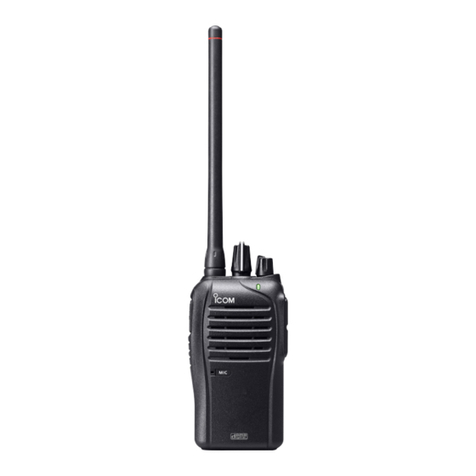
Icom
Icom iDAS IC-F3103D User manual
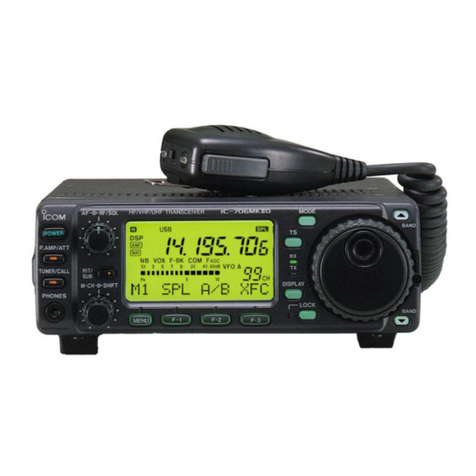
Icom
Icom IC-706MKIIG User manual
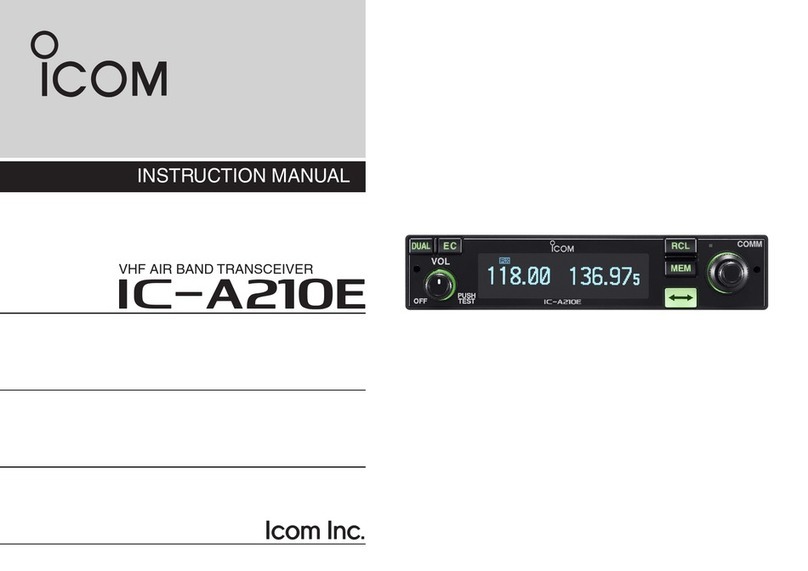
Icom
Icom IC-A210E User manual
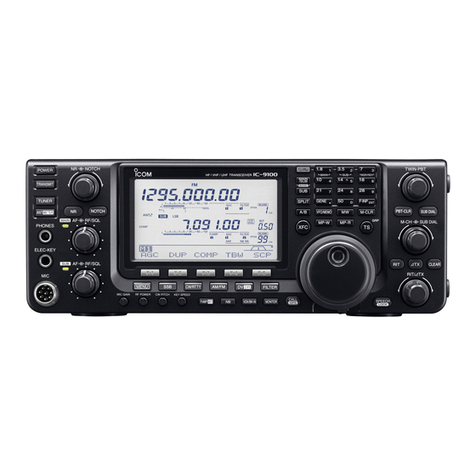
Icom
Icom IC-9100 User manual
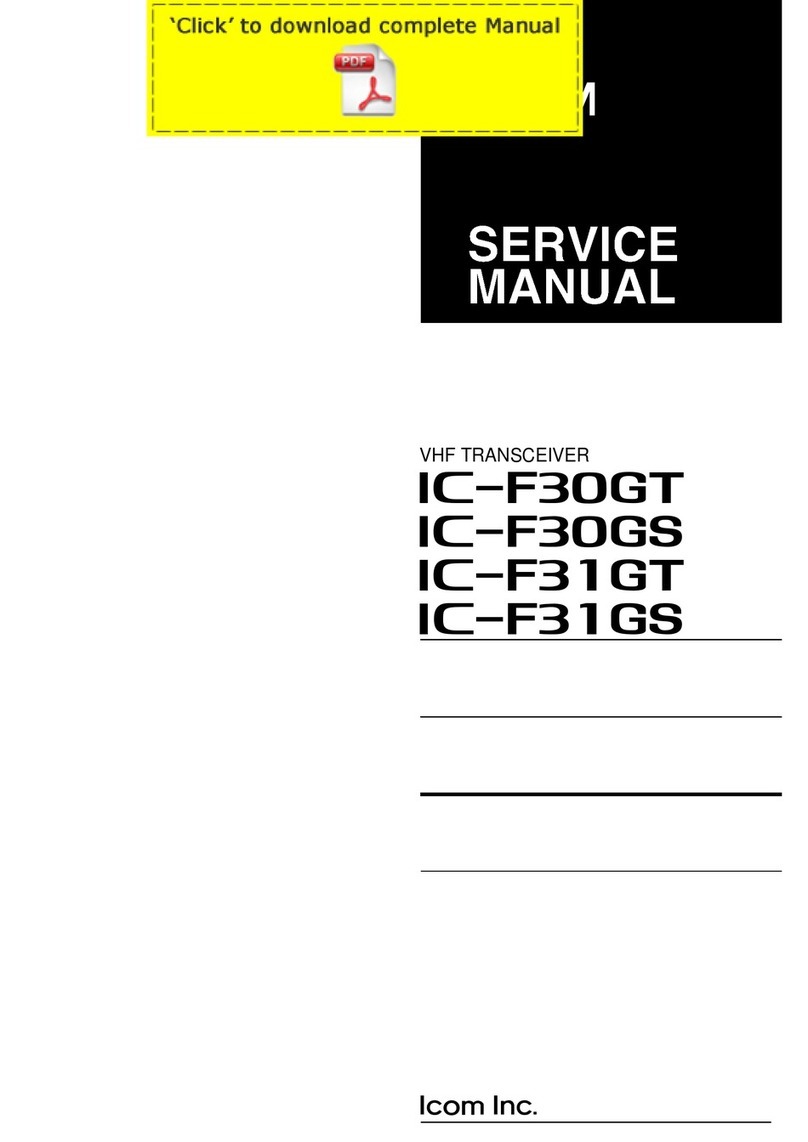
Icom
Icom IC-F30GT User manual
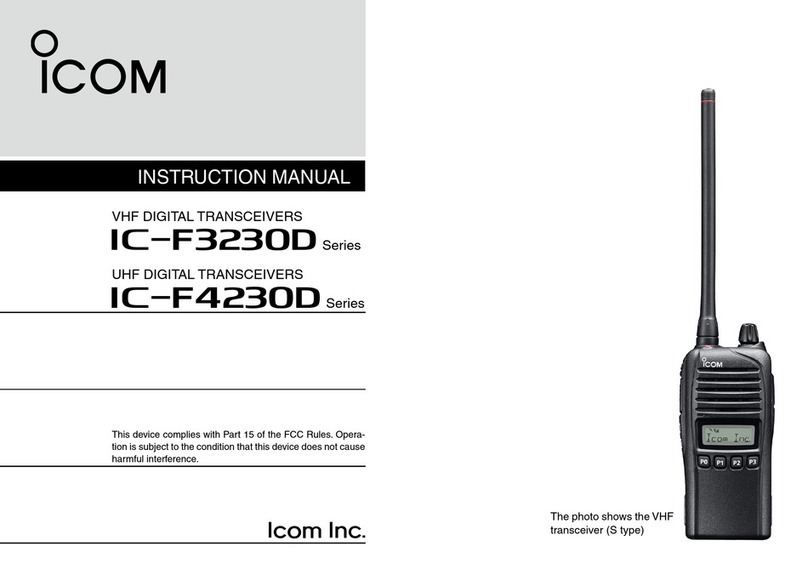
Icom
Icom IC-F3230D User manual
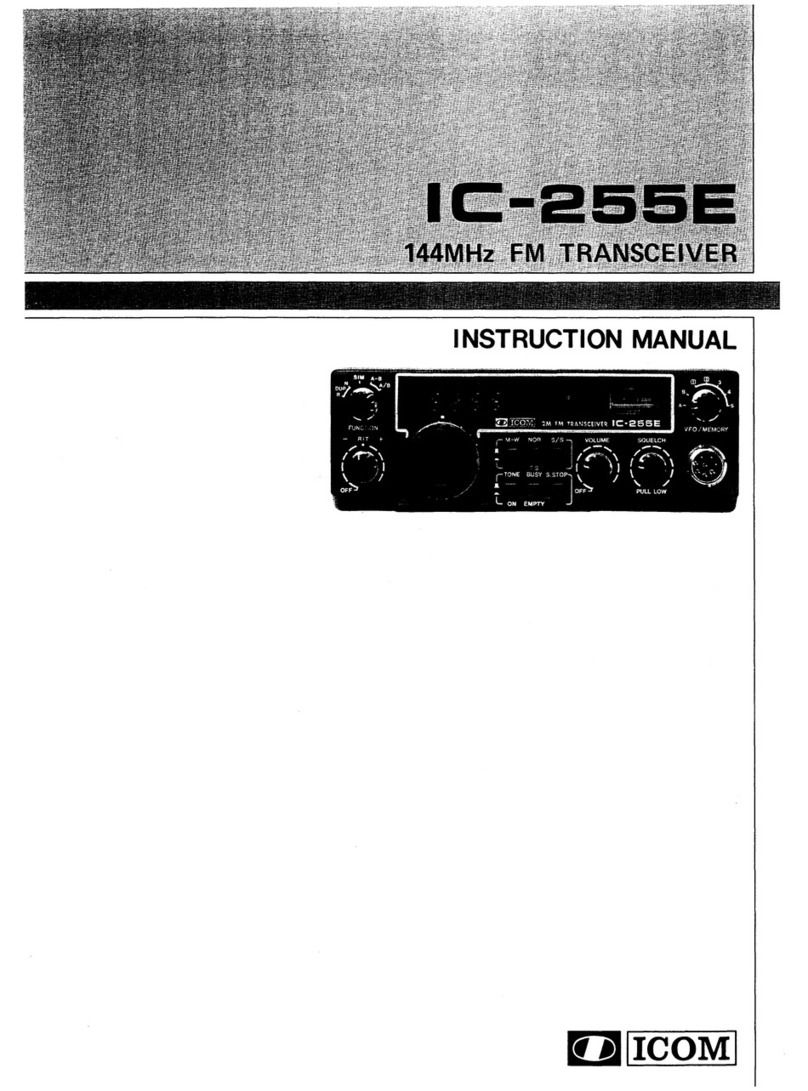
Icom
Icom IC-255E User manual
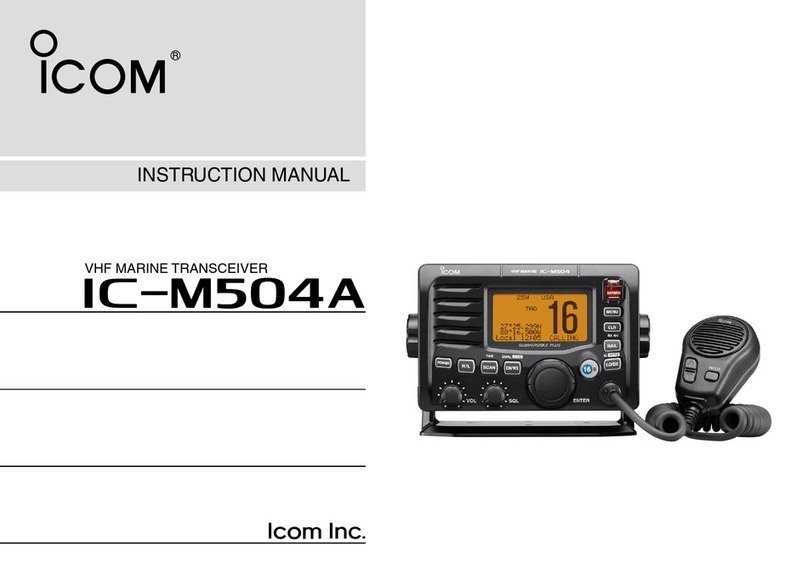
Icom
Icom IC-M504A User manual

Icom
Icom IC-V8000 User manual
Popular Transceiver manuals by other brands
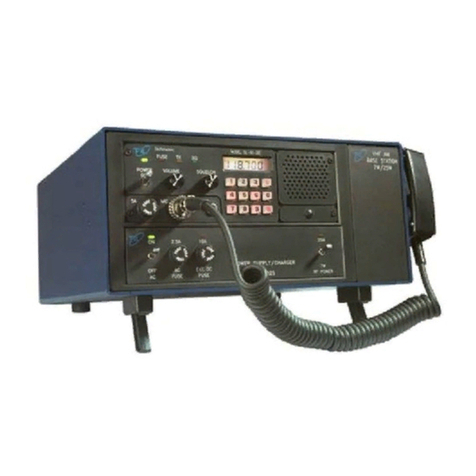
Technisonic Industries Limited
Technisonic Industries Limited TiL-91-DE/S Installation and operating instructions
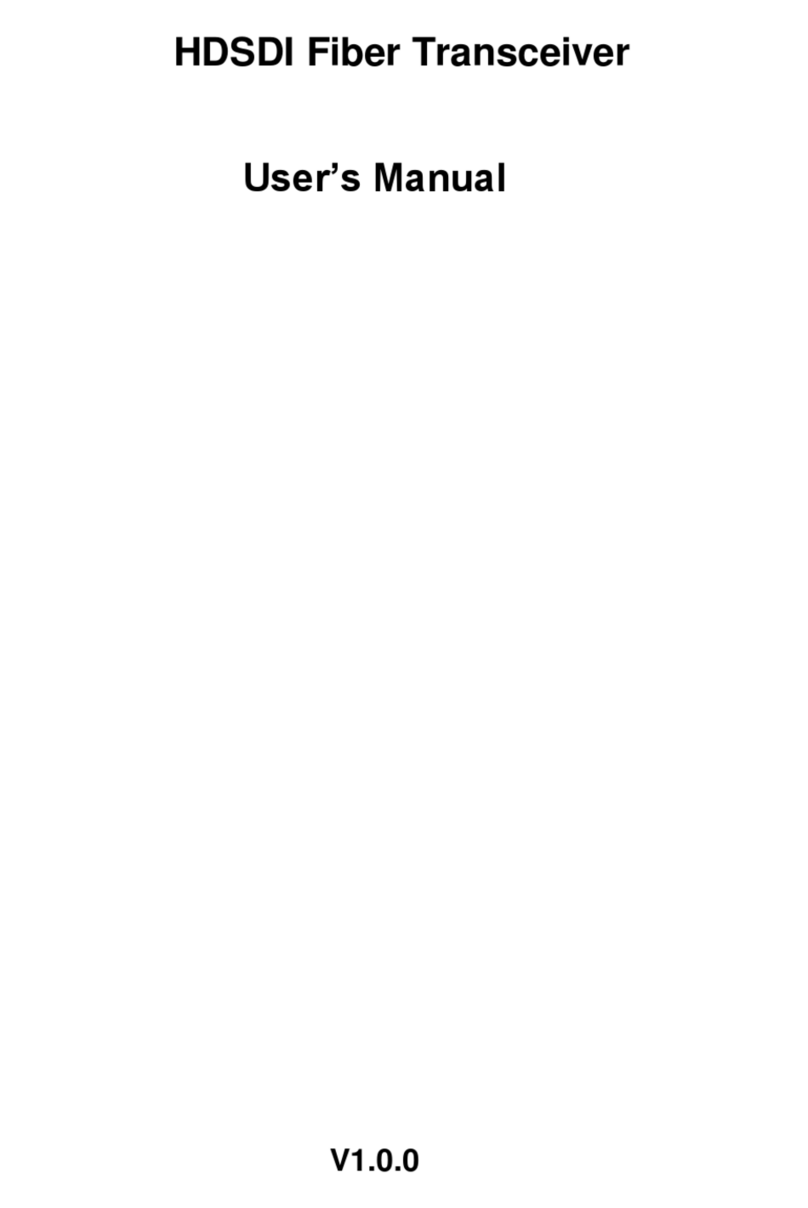
Dahua
Dahua OTS102T user manual

Hytera
Hytera PT350 Quick reference guide
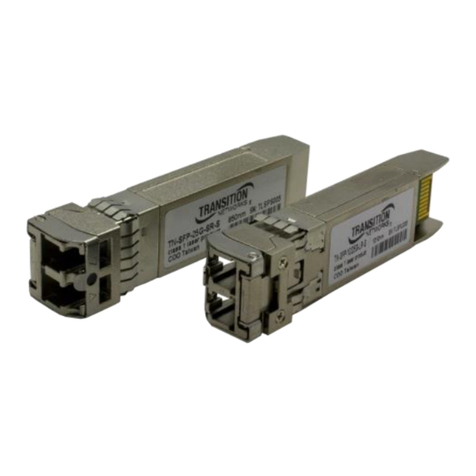
Transition
Transition TN-SFP Series user guide

Kenwood
Kenwood TH-79A instruction manual
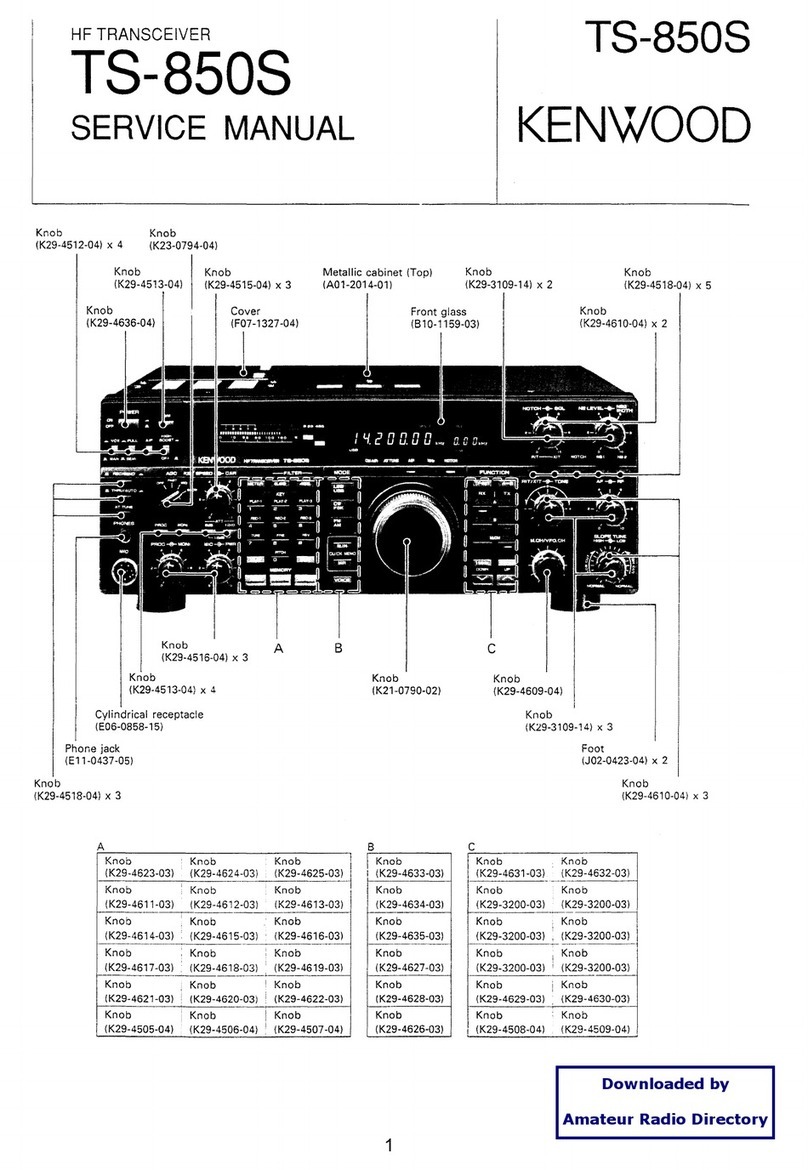
Kenwood
Kenwood TS-850S Service manual
